Trip Report
Baja California
Whales and
Wildlife
Photo Tour
2015
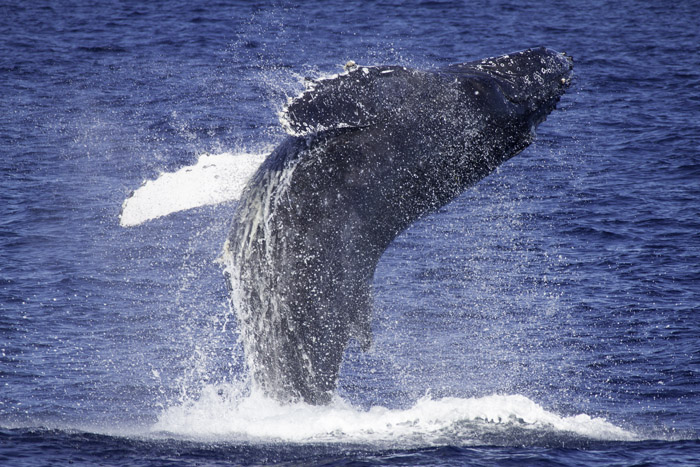 Breaching Humpback Whale by Tom Base, one of the participants on the trip!
Breaching Humpback Whale by Tom Base, one of the participants on the trip!
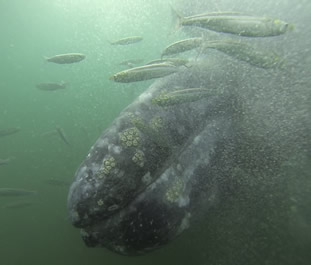 Gray Whale, a screen capture from a GoPro, as the whale visited our skiff.
Gray Whale, a screen capture from a GoPro, as the whale visited our skiff.
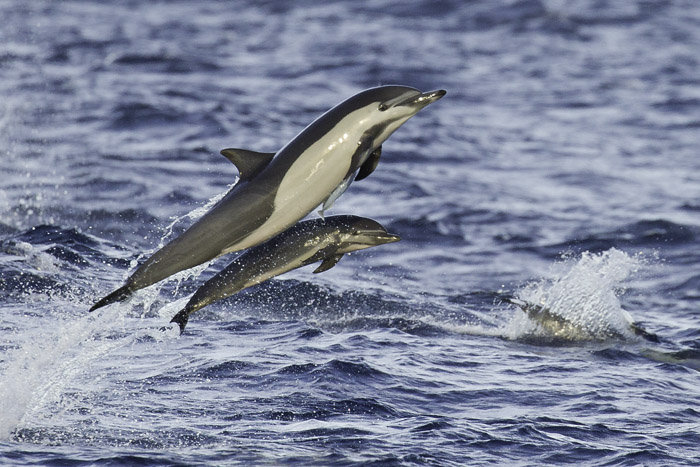 A mother Short-beaked Common Dolphin and baby by Mary Ann.
A mother Short-beaked Common Dolphin and baby by Mary Ann.
It was almost 15 years ago we had last visited Baja California and did a whale/dolphin shoot. That was in film days, and although those two trips were exciting, they were very, very frustrating as well. Photographing porpoising dolphins as they raced across the water, usually just beneath the surface, was a challenge. All of the photographers on those trips wanted to get Dolphins when they cleared the water, but to do so one had to fire the camera shutter before a dolphin's head cleared the water. If you waited until a dolphin cleared the water it was too late, and all you caught was the tail disappeared into the waves. With film, obviously, we had to budget our shooting and hope for the best, and with the ISOs at that time, shooting was very, very tough! Now ... we were doing this same trip with digital, and we were so looking forward to it!
With digital, obviously, we could fire away without worrying about the expense or waste that film entailed. And I am sure, because of that, our shooting this time was extremely rewarding. Obviously we still tried to catch Dolphins as they cleared the water and we were frustrated by looking at the wrong place at the wrong time, but even so, we still had a lot of success - as we did with Humpback Whales breaching, an Orca breaching, spy-hopping Gray Whales, curious Pilot Whales, and more.
We used the whale-watching boat, the Searcher, captained by Art Taylor and a great crew -- Ryan, Aaron, Joe, Dan, and Charles, the same boat we used all those years ago. Our group of 16 was a sub-group of the entire passenger contingent, which included two others from the US and six from the UK, including a lovely honeymooning couple. The group gelled and the non-photographers would do their skiff excursions with Patti, the ship naturalist, while the photographers went with Mary and I in separate skiffs.
Although there may have been a few times when our 500mms would have been handy, or my heavy 200-400mm, for this trip our longest lenses were our 400mm f5.6 lenses, very sharp, and relatively light. Mary borrowed our friend Tom's 100-400mm lens and loved it (she'll be getting one), and I used my 70-300mm for most of my whale shots, sometimes mounted on a 7D for extra reach. Because we were using smaller gear we could carry everything we needed in our Gura Gear Kiboko bags, instead of our usual Bataflae bags. We also used the Gura Gear Chobe bags, which we used to carry our laptops and some camera bodies -- perfect for getting all of our gear onto the planes.
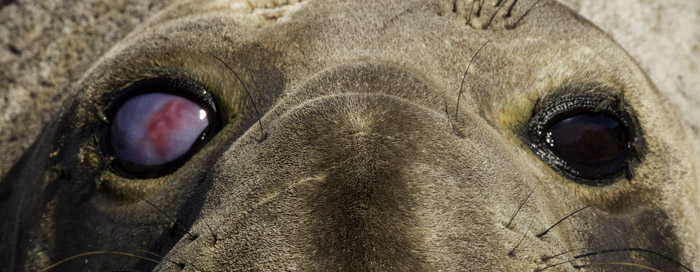 Because we only carried smaller lenses we used the Really Right Stuff BH40 for all of our shooting. On the boat most of the shooting was hand-held, so we only used our Really Right Stuff tripods on land, but I wouldn't have traveled here without them. For our land-based work, with the unique Rattleless Rattlesnake of Catalina Island and Birds and Seals and Landscapes, a tripod was an essential.
Because we only carried smaller lenses we used the Really Right Stuff BH40 for all of our shooting. On the boat most of the shooting was hand-held, so we only used our Really Right Stuff tripods on land, but I wouldn't have traveled here without them. For our land-based work, with the unique Rattleless Rattlesnake of Catalina Island and Birds and Seals and Landscapes, a tripod was an essential.
As usual, Mary and I and many of our participants used Hoodman CF cards. I was using 64gb cards and Mary was using 32gb cards, and sometimes with the dolphins we used up the cards. In one session, lasting only about an hour, Mary shot over 64 gigs! A couple of photographers only had 8gb cards with them, fearful and hanging on to the old worry that a card might fail and all of their images, if on one card, would be lost. We have never had a Hoodman card fail us, and use the largest cards they have with absolute confidence. If you are worried about card failure you are probably using the wrong cards. Hoodman cards work! With the firmware upgrade for their Steel 3.0 card reader I could download a full card in only a few minutes.
Most of our participants were veterans from many past trips and most of those also had been to our Complete Digital Nature Photo Course or were experienced shooters. Most shot Manual Mode, Spot-metering, which we teach in that course and that exposure method was invaluable on this shoot, as flying birds could be above the water and in the sky, or below the horizon line and against the sea, and program metering modes would be all over the place. On Manual Mode that is not an issue, whether for flying birds, breaching whales, or seals shot from a bouncing skiff. As always, I wish everyone would take that course!
Patti, our naturalist, kept excellent records, keeping track of the various species we saw. This included 12 Marine Mammals, 88 Birds, 4 Reptiles, 13 Invertebrates, and 36 fish. All but two or three of the mammals were satisfactorily photographed, and more than half the birds, although some of the seabirds were too far off and too small a bird for a good shot.
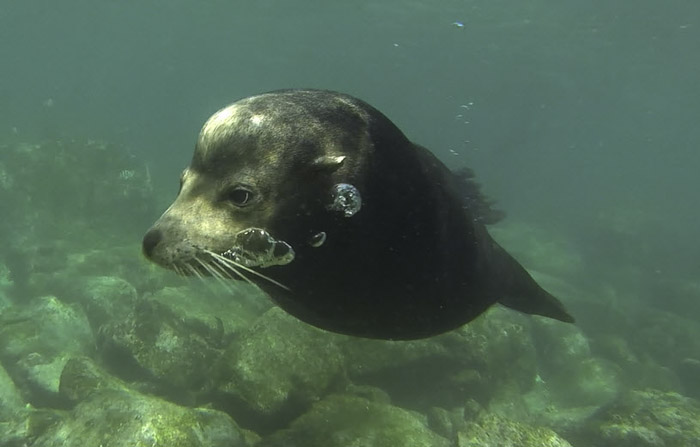
In short, it was an excellent trip and more than met our expectations and hopes. Admittedly, I missed a couple of great shots -- stupidly chimping instead of keeping alert for a breaching Humpback Whale (Tom got it!), using my GoPro for video instead of having my wide-angle ready when a Gray Whale practically put its head into our skiff, and taking a shower too early, when a pod of Orcas suddenly visited our boat. Still, we enjoyed wonderful shooting as you'll see as you go through this report.
One last word first. We are planning on our next trip in 2017, and if you are interested, contact us ASAP and we'll get you on our first contact list. Some of this year's participants are already signed up for the next trip, and we only wish we had time in our 2016 schedule to fit one in next year!
Here's the Trip Report:
Jan. 23. San Diego and heading South
Everyone arrived in plenty of time for a luggage transfer and a lengthy wait until our 8PM boarding of the Searcher and a 10PM departure into the open seas. High winds were forecasted but never materialized and we sailed out of San Diego in soothing calm seas and under a star-filled, cloudless sky. One of our participants tripped as he crossed a street, and thought he may have injured his elbow. He did not – he broke his shoulder instead, and had to cancel the trip. A terrible loss for us, as we would miss his company on the trip.
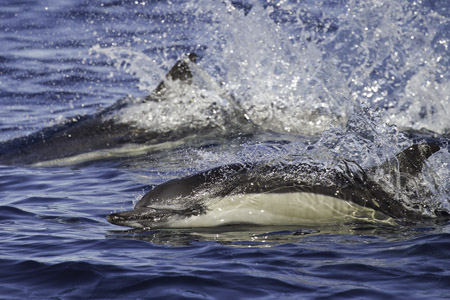
Jan 24. Mexican Customs, Ensenada Harbor and heading South
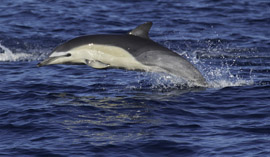 No wind and clear skies. A variety of seabirds passed us throughout the morning, and in mid-morning hours we had a pod or herd of about 300 Pacific Dolphins swimming about. Many breached, flipping onto their backs or sides, and several raced up to our boat to bow-ride. Although we stayed with the dolphins about an hour and we shot constantly, I found I didn’t actually shoot very much – often the dolphins were too far away or would rush in close so quickly that they did so almost unnoticed. Still, it was great fun to watch the dolphins and everyone did manage a few good shots.
No wind and clear skies. A variety of seabirds passed us throughout the morning, and in mid-morning hours we had a pod or herd of about 300 Pacific Dolphins swimming about. Many breached, flipping onto their backs or sides, and several raced up to our boat to bow-ride. Although we stayed with the dolphins about an hour and we shot constantly, I found I didn’t actually shoot very much – often the dolphins were too far away or would rush in close so quickly that they did so almost unnoticed. Still, it was great fun to watch the dolphins and everyone did manage a few good shots.
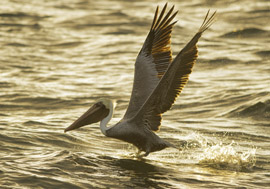 We started our shooting, however, right after clearing Mexican customs, where at a rocky outcrop with Pacific swells sweeping in and crashing over the barren rocks we had Elephant Seals, California Sealions, Harbor Seals, Brown Pelicans, a variety of gulls, and Cormorants and Common Loons. Our dolphin encounter soon followed.
We started our shooting, however, right after clearing Mexican customs, where at a rocky outcrop with Pacific swells sweeping in and crashing over the barren rocks we had Elephant Seals, California Sealions, Harbor Seals, Brown Pelicans, a variety of gulls, and Cormorants and Common Loons. Our dolphin encounter soon followed.
We had two different lengthy encounters with migrating Gray Whales, although they did little more than blow spray or sound, displaying their roundish, paddle-like flukes as they sounded. Mid-afternoon we had 7 Orcas, or Killer Whales, that were fishing, and whose presence we often detected by the gulls and shearwaters that would fly about, hover, and land where the whales would surface. Several times we had a large male swim close to our boat, and the shooting was productive.
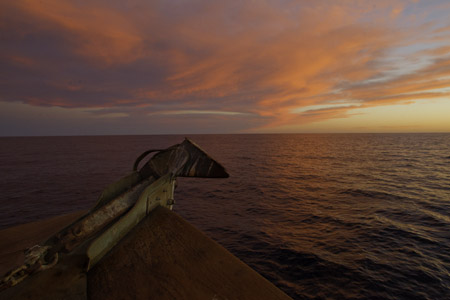 At sunset the skies were clear enough for us to see the Green Flash, an optical phenomenon where the sun radiates a green flash – literally, the moment the sun disappears below the horizon line. Several of us tried shooting it but without success. I was using live-view so that I could watch the sky without frying my eyes, and with a 400mm on a 7D, at 560mm, I had a close-up view and could clearly see the flash – a bright flash of gatorade green that I missed shooting. I could see it but doing so it is too late to shoot! We’ll try again tomorrow, weather permitting.
At sunset the skies were clear enough for us to see the Green Flash, an optical phenomenon where the sun radiates a green flash – literally, the moment the sun disappears below the horizon line. Several of us tried shooting it but without success. I was using live-view so that I could watch the sky without frying my eyes, and with a 400mm on a 7D, at 560mm, I had a close-up view and could clearly see the flash – a bright flash of gatorade green that I missed shooting. I could see it but doing so it is too late to shoot! We’ll try again tomorrow, weather permitting.
Jan. 25. West San Benito Island
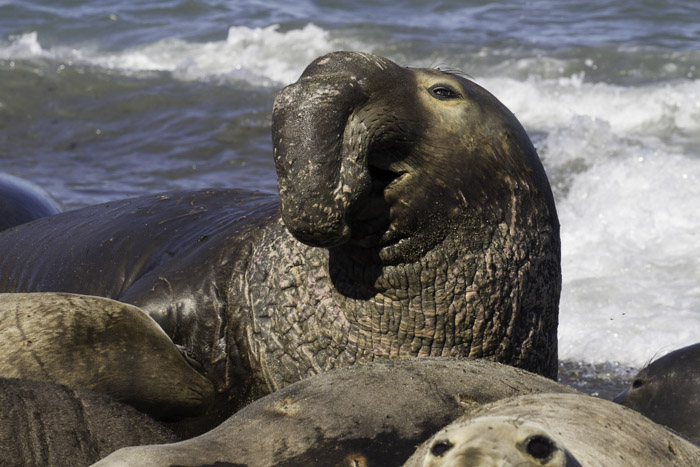
The day started with our ship cruising into the San Benito Islands where several Northern Elephant Seal haul outs occupy the stone beaches. We landed at 9, and then most of us took a torturous hike along the shoreline, bushwhacking up a ravine, uphill, until we reached a main trail that led, eventually, to a lighthouse. The going was miserable and every step, quite literally, had to be carefully placed to avoid being stabbed and secured by a Cholla cactus pad. The two times I did not watch my footing I was harpooned and the rest of the time I walked in dread, hoping I wasn’t missing a hidden cactus.
When we summited the hill I found we still had 2/3rds of a mile to cover and I elected to join Mary at the elephant seal colony, which gave us two productive hours of shooting. Most of the group continued on what ended up to be nothing more than a forced march, with no time to photograph.
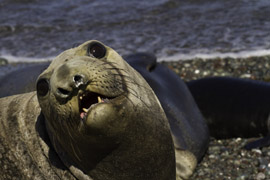 The one Elephant Seal beach was unsettling, with what appeared to be 50% mortality of babies – dead, rotting, skinless, red carcasses, or fresh ones gleaming ghostly and ghastly white in the surf. I suspect a food shortage has the females leaving the beaches before the babies are weaned, and they starve.
The one Elephant Seal beach was unsettling, with what appeared to be 50% mortality of babies – dead, rotting, skinless, red carcasses, or fresh ones gleaming ghostly and ghastly white in the surf. I suspect a food shortage has the females leaving the beaches before the babies are weaned, and they starve.
Several colorful Side-blotched Lizards scurried about, and I managed some photos. One Osprey plummeted to sea, grabbing a large fish. Peregrine Falcons flew overhead with one tormenting a Red-Tail Hawk.
Towards late afternoon the sea was covered in a flotilla of Red Crabs, little shrimp-like crabs that numbered in the millions. Charles, our chef, extended his GoPro on a long pole and did some interesting video of the two inch crabs floating along, bobbing in the swell.
The skies were just a bit murky for the Green Flash but Cindy caught it this evening. I did not, and most simply missed the Green Flash, which concluded our day.
Jan. 26. San Ignacio Bay
We motored all night to reach the mouth of the San Ignacio Lagoon by 6AM. Waves crashed over hidden sandy shoals, making our entrance into the lagoon nerve-wracking for the captain but we entered without incident. At 9:30 the Kysuma pangas (skiffs) met our boat and we departed on a 3 hour whale cruise just as it began to rain. For the next hour or so it rained, heavily at times, and at least Mary and my rain gear was anything but waterproof, and we were drenched to the skin and cold.
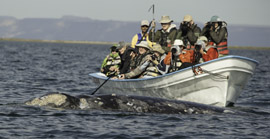 The whales, however, were great and several spy-hopped, rising out of the water like missiles to survey their surroundings before sinking back and disappearing. We had two or three curious mothers with calves and we had them close enough that we could almost touch them. The weather continually improved and the sun finally came out, beginning to warm and dry us.
The whales, however, were great and several spy-hopped, rising out of the water like missiles to survey their surroundings before sinking back and disappearing. We had two or three curious mothers with calves and we had them close enough that we could almost touch them. The weather continually improved and the sun finally came out, beginning to warm and dry us.
We returned to the boat by 11, and 90 minutes later did the first of two 90 minute excursions. My skiff had little luck on the first leg but did OK on the second, while Mary’s skiff on the second had my skiff captain from the first leg, where we had no luck, but now they did quite well. Indeed, I think everyone did, as well as getting shots of Brandt’s Cormorants, Surf Scoters, and Loons.
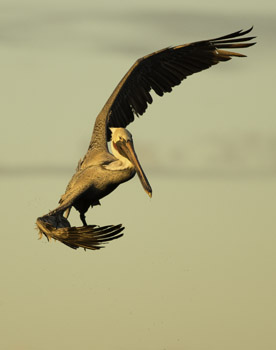
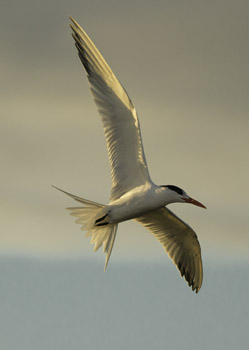
Before dinner Brown Pelicans and Royal Terns fished around our boat, capitalizing upon a huge ball of bait fish driven to the surface by predatory fish. We hoped for another Green Flash, but a spit of land blocked the sea’s horizon line and we saw nothing.
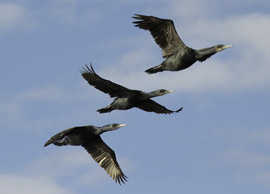 After dinner, our captain turned off the engines and we spent nearly a half hour in the dark, hoping for bioluminescence but strangely there was none, despite the fact that seals swam about the boat. Once, as I leaned over the rail to watch, one of the lenses from my glasses popped out and dropped into the sea! This was the third time I’ve almost lost a lens since I had these glasses, and of course this had to happen when I was overlooking water! Fortunately I had another pair – but I was not happy!
After dinner, our captain turned off the engines and we spent nearly a half hour in the dark, hoping for bioluminescence but strangely there was none, despite the fact that seals swam about the boat. Once, as I leaned over the rail to watch, one of the lenses from my glasses popped out and dropped into the sea! This was the third time I’ve almost lost a lens since I had these glasses, and of course this had to happen when I was overlooking water! Fortunately I had another pair – but I was not happy!
Whales blew, and cloud cover eventually covered the half moon when we turned on the engine and resumed editing before getting to bed.
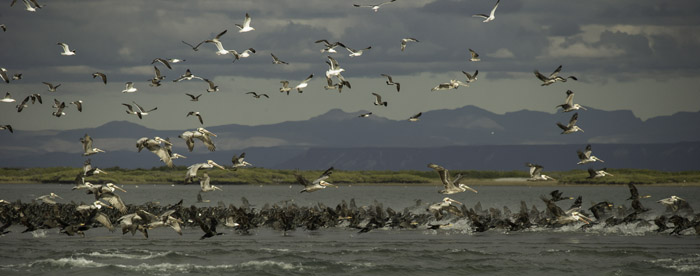
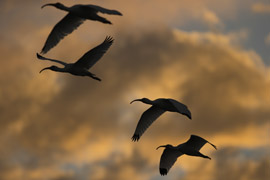 Jan. 27. San Ignacio
Jan. 27. San Ignacio
We awoke at 6 for an early breakfast and left for our first panga ride around 7:30. There was some chop but clear skies and no rain.We did four whale excursions today, with two before lunch and two afterwards. 3 of 4 were productive, and only the 3rd was not so. On that one, right after lunch, we had whales, but none came close and we motored about, trying to find a friendly whale, but without success. On the other three excursions however, we had spy-hopping, tail lobbing, and friendly babies, and a few people had the thrill of their lives, actually getting a chance to pet babies.
In the late afternoon there was no wind and the seas at time were pond-like, a mirror of the sky, where the horizon merged seamlessly with the sky as spy-hopping whales surfaced nearby.
Both morning and afternoon we had a friendly mother and baby which both Mary, Judy, and I caught with GoPro cameras. Judy got an incredible sequence – a side view of the baby swimming around the mother, while Mary had a front-view, a bit off-center, showing the same thing. I had one contact where the whale came face on, providing some nice shots.
 The turbidity of the water is such that anything further than 10 feet is lost in the murk, but it was somewhat magical, viewing the video afterward, to have a whale take shape as a vague amorphous darkness, growing in definition and outline until it became a whale. If it came close enough the barnacles and pattern grew clear, and then the whale passed by, its body smoothly gliding below or beside the camera.
The turbidity of the water is such that anything further than 10 feet is lost in the murk, but it was somewhat magical, viewing the video afterward, to have a whale take shape as a vague amorphous darkness, growing in definition and outline until it became a whale. If it came close enough the barnacles and pattern grew clear, and then the whale passed by, its body smoothly gliding below or beside the camera.
Admittedly I missed a lot of shots because I was doing a GoPro rather than a camera, but my goal was to get some underwater shots and I accomplished that. Still, seeing other people’s work I looked with envy at what they caught – particularly spy-hops and some front on views.
Jan. 28. Off the Baja coast heading south
Most of the day was extremely uneventful with a few birds, including a few Red-billed Tropicbirds and a bobby or two, but otherwise we simply cruised south. Several of us occupied part of the time by walking circles around the boat, welcome exercise when ship bound.
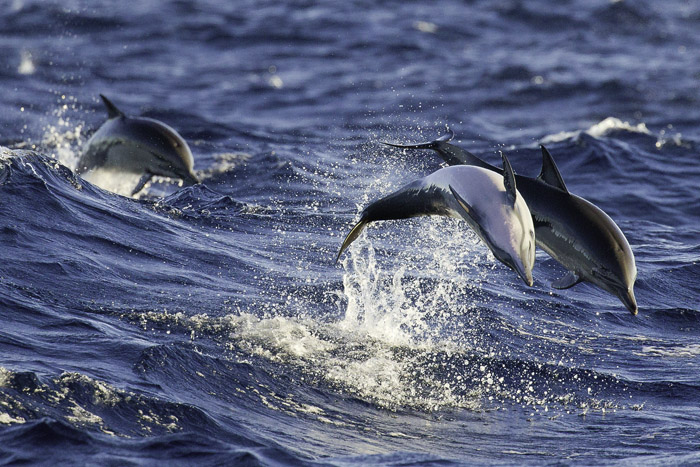
However, the last hour of the day was magical and one of the events I most hoped to see on this trip. Around 4:30PM one of the crew spotted 1,000 Short-beaked Common Dolphins ahead of us and we had 45 minutes of pure excitement. We followed the dolphins, turning several times to position the dolphins, and in doing so rocking the boat violently. Twice I went flying, wrenching my bad shoulder one time, and crashing into Michelle another. Later, leaning over the fiberglass splash guard another wave pushed me forward, and I shattered the glass from the holder. Luckily it went sailing out to sea and didn’t hit anyone.
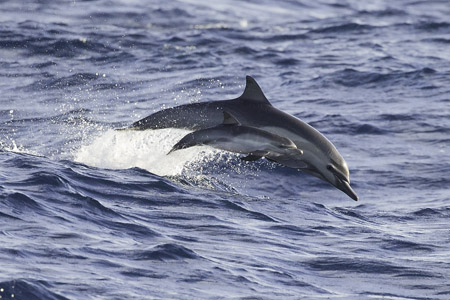 Mary ended up shooting 64 gigs, and I shot 29. There were a huge number of deletes, with most of the shots catching dolphins as they reentered the water. But, for all the mistakes, we had some great ones. Looking at Mary’s material a second ago, she captured a mother and baby in mid-leap, with the baby shadowing beneath the mother. I caught a sequence early on, one of my best, where a dolphin cleared the water and did a nice arch, with two Remoras, parasitic fish that anchor to the bellies or sides of sharks (usually), attached to the sides of the dolphin. How that fish remains attached with the speed and diving and jumping is a testament to their suction.
Mary ended up shooting 64 gigs, and I shot 29. There were a huge number of deletes, with most of the shots catching dolphins as they reentered the water. But, for all the mistakes, we had some great ones. Looking at Mary’s material a second ago, she captured a mother and baby in mid-leap, with the baby shadowing beneath the mother. I caught a sequence early on, one of my best, where a dolphin cleared the water and did a nice arch, with two Remoras, parasitic fish that anchor to the bellies or sides of sharks (usually), attached to the sides of the dolphin. How that fish remains attached with the speed and diving and jumping is a testament to their suction.
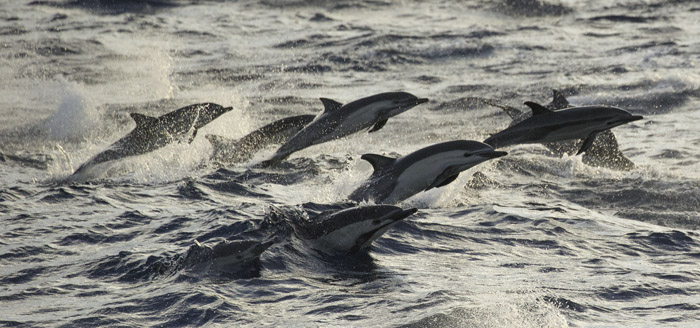
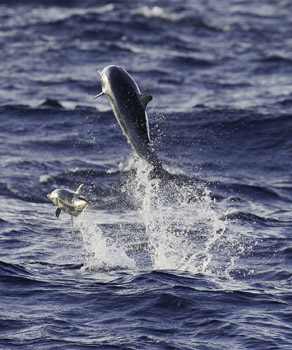
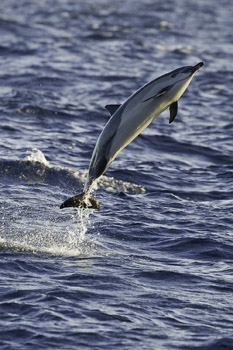
The last light of the day disappeared behind low western clouds and we left the dolphins, exhausted and a bit beaten up from the seas, but elated by what is truly one of the world’s great wildlife spectacles.
Jan. 29. Gorda Banks and Los Frailes
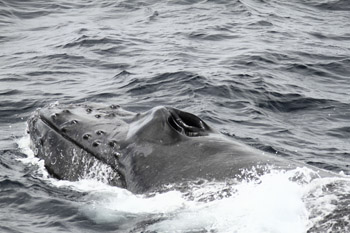 We spent the morning chasing Humpback Whales off the Gorda Banks. Tom Base had a great shot when one unexpectedly breached right in front of our boat, and he nailed it with a full frame shot. That shot motivated the rest of us to try for more breaching and although more breaching occurred, the breaching was too far away for shots. Photo, left, by Tom Base.
We spent the morning chasing Humpback Whales off the Gorda Banks. Tom Base had a great shot when one unexpectedly breached right in front of our boat, and he nailed it with a full frame shot. That shot motivated the rest of us to try for more breaching and although more breaching occurred, the breaching was too far away for shots. Photo, left, by Tom Base.
In the afternoon we anchored off Los Frailes where we went for a bird walk, hoping to, and finding, Gray Thrashers (an endemic) and Xanthus Hummingbirds (a Baja specialty). In all we saw or photographed about a dozen species, including Hooded Oriole, Loggerhead Shrike, Pyrrhuloxia, Verdin, Cactus Wren, Turkey Vulture, Magnificent Frigatebird, Elegant Tern, Yellow-footed Gull, House Finch, and three species of Dove.
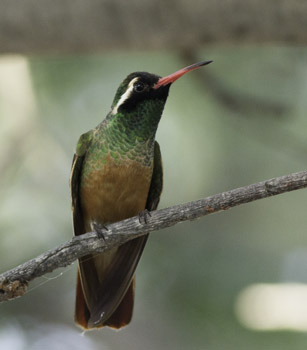
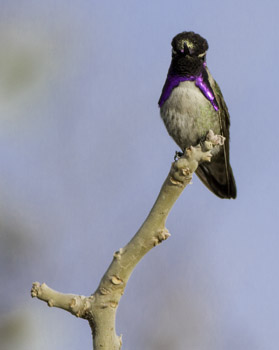
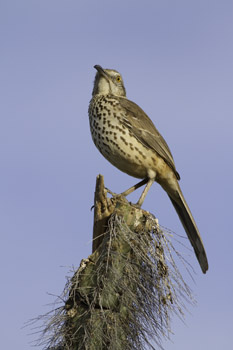
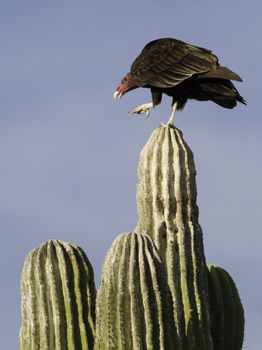
Clockwise, from upper left: Xanthus Hummingbird, Costa Hummingbird,
Turkey Vulture, Gray Thrasher
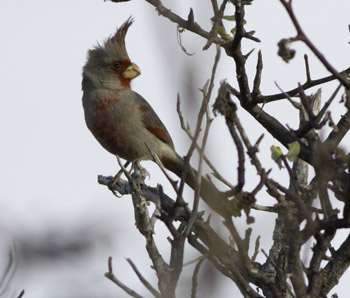
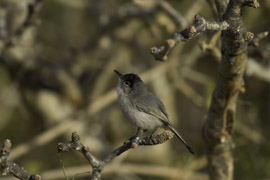
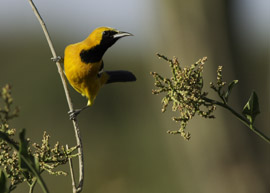
Pyrrhuloxia, California Gnatcatcher, Hooded Oriole
We met Katy and Mel who had bird feeders and welcomed birders to visit, and there we had the Xanthus Hummer. Some of the group snorkeled, but most of us just went ashore to bird and photograph. The snorkelers enjoyed themselves as well.
Jan. 30. Los Frailes and north into the Sea of Cortez
We started the day back on the beach where people returned, hoping to see the Thrasher and the Hummer. We were successful and saw most of the birds listed above.
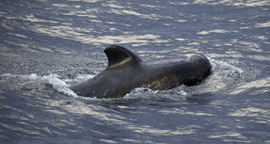 When we left anchor and headed north the weather was poor and some people got seasick and stayed in their cabins. It rained and was dreary, but at the end of the day the weather cleared somewhat and we had another bout with Dolphins – this time, long-beaked Common Dolphins, and later with a small group of Black Fish, or Pilot Whales. They swam close and although the light was getting to be past marginal we had some shooting and very good sightings.
When we left anchor and headed north the weather was poor and some people got seasick and stayed in their cabins. It rained and was dreary, but at the end of the day the weather cleared somewhat and we had another bout with Dolphins – this time, long-beaked Common Dolphins, and later with a small group of Black Fish, or Pilot Whales. They swam close and although the light was getting to be past marginal we had some shooting and very good sightings.
Jan. 31. Punta Colorado and north in the Sea of Cortez
We all awoke pre sunrise to shoot the unusual red sandstone cliffs, but low clouds in the east diluted the effect. The light was low, but the cliffs still glowed in the predawn light and had it been clear, with a dark cloud cover in the west, the scene would have been spectacular.
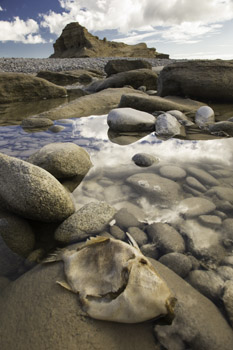
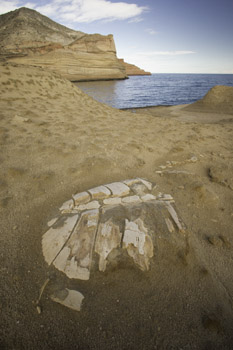
After breakfast we headed ashore where we walked the cliffs, photographing the colorful eroded rocks, pools, and fossilized shells that marked the different strata. 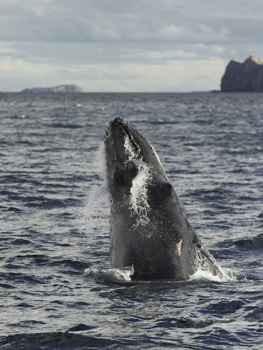 In the right layer every two inches or less had a shell sticking out, with the strata being about 8 inches deep. A fossilized whale vertebrae and a sea turtle carapace, also entombed, made for wonderful shots and washed up fish skeletons and eels rounded out the shore excursion.
In the right layer every two inches or less had a shell sticking out, with the strata being about 8 inches deep. A fossilized whale vertebrae and a sea turtle carapace, also entombed, made for wonderful shots and washed up fish skeletons and eels rounded out the shore excursion.
Afterwards, most of us snorkeled, and Mary got some OK video of puffer fish with her GoPro, while I had my camera aimed too high and got nothing.
In the afternoon we almost passed on two Humpback Whales that were breaching in the distance, but after counting over 37 breaches we decided to head over. In all 87 breaches occurred, and one was completely out of the water, while I was chimping and missed the shot!
A round-finned Mandela, a type of Sting Ray was leaping beside the boat and we got some shots, but the whale stole the show.
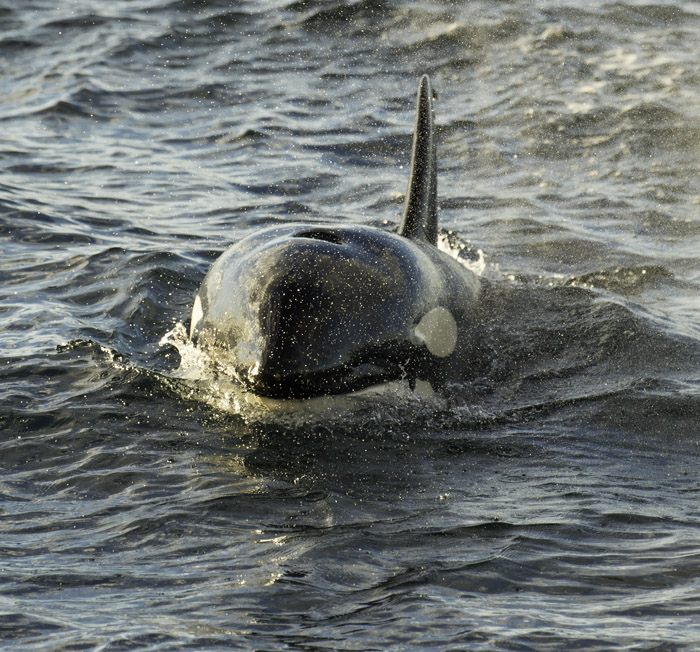
Towards sunset we had still another group of Orcas, 10 total, that was a different group from the ones we had off the Pacific previously. The Orcas were curious and approached the boat several times, and turned upside down and wagged their distinctive tails in the air. It was a great show.
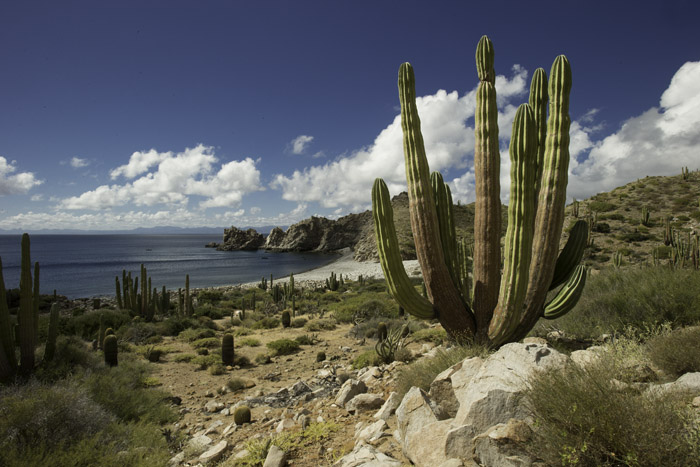
Feb. 1. Santa Catalina Island
We came ashore to one of the prettiest islands, with huge Cordon Cactus and the home to the most unique Rattlesnake species, the Catalina Rattleless Rattlesnake. I found one, a small 14 inch long snake coiled by some grasses. I managed some shots before it took off and before I could call anyone to come see the snake. That may have been a moot point, as the countryside was horrendous, steep, crumbly rock, that threatened to break my ankle every few feet.
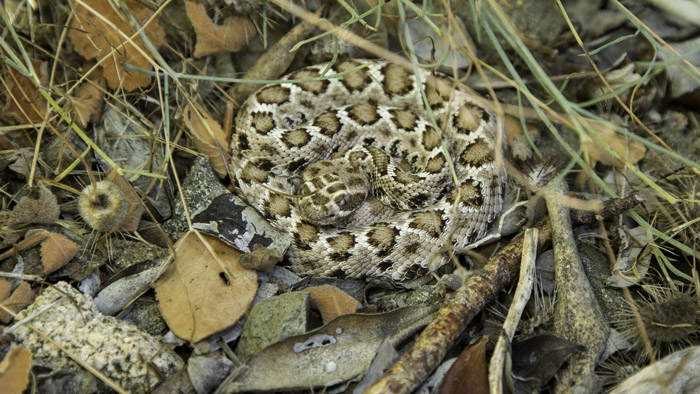
When the rest of the crew returned to the ship to either snorkel or do a skiff ride, Mary and I stayed on and looked for another snake, but we were unsuccessful.
Looking for snakes in this habitat is tough. The footing was treacherous, with loose rock and unexpectedly steep slopes, and several times I had to backtrack and try to retrace my steps to find a way back down into the arroyo. We looked very thoroughly but had no luck, and returned to the ship a little disappointed in not having another chance at seeing this snake.
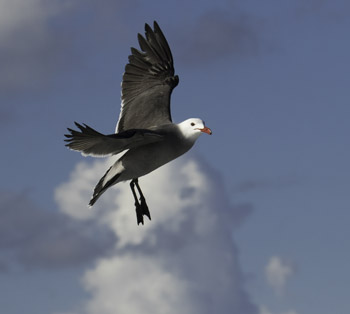
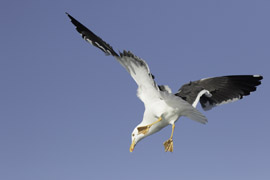
Heermann's Gull, Yellow-footed Gull
After lunch we had an encounter with a Bryde’s Whale, which surfaced close to the boat but offered no real shots. Patti and Cindy chummed, drawing in Heermann’s and Yellow-footed Gulls and while we shot them a large pod or herd of Long-beaked Common Dolphins swam in and we had some good shooting for about 30 minutes before they just disappeared.
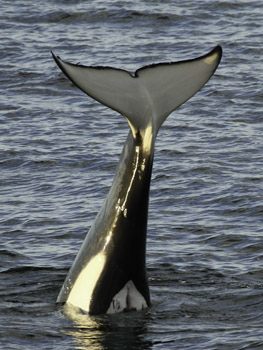 In the last light of afternoon Mary and I decided to get our shower, and while doing so we could hear Art, the Captain, announcing Orcas! We were in almost the exact same spot as yesterday, and we had the same group. This time they were extremely active, tail-slapping and one fully breached, which Judy, Cindy, and Nancy caught, while I just watched! About 30 Short-lobbed Pilot Whales appeared in a tight pod and swam towards the Orcas, who swam off. The Pilot Whales swam close around our boat, but the light was so low I simply stood and watched.
In the last light of afternoon Mary and I decided to get our shower, and while doing so we could hear Art, the Captain, announcing Orcas! We were in almost the exact same spot as yesterday, and we had the same group. This time they were extremely active, tail-slapping and one fully breached, which Judy, Cindy, and Nancy caught, while I just watched! About 30 Short-lobbed Pilot Whales appeared in a tight pod and swam towards the Orcas, who swam off. The Pilot Whales swam close around our boat, but the light was so low I simply stood and watched.
Photo, left, by Tom Base.
Feb. 2. Isla San Jose, Los Islotes, and heading South
We started the day in a mangrove bayou at Isla San Jose, where we looked for a subspecies of Yellow Warbler, a Mangrove Yellow Warbler with a chocolate brown head and neck. We found several and managed a few images. I was using Mary's 7D Mark II (the issues we had with it in Chile [Pumas in Patagonia] we seem to have resolved and the camera worked fine) but Mary keeps her back multi-control wheel on AV and the front one on TV -- EXACTLY opposite of what I do. I find it far easier to roll the shutter with my thumb wheel and keep the aperture set, while firing away, but I can't convince Mary to change. So ... I rolled my thumb wheel and ended up at crazy apertures, and shutter speeds, blowing most of the shots. After that I said the heck with it and changed the camera for my arrangement! Still, I got a few shots, but missed the best ones at too slow a shutter speed.
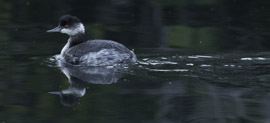 We had several species of herons and egret, and a really close and cooperative Eared Grebe that swam by unconcerned. After breakfast, while cruising, we had more Pilot Whales as we headed to Los Islotes for California Sea Lions.
We had several species of herons and egret, and a really close and cooperative Eared Grebe that swam by unconcerned. After breakfast, while cruising, we had more Pilot Whales as we headed to Los Islotes for California Sea Lions.
At the sea stacks we cruised the leeward side of the rocks, photographing the Sea Lions as they swam around our skiffs or lounged on the rocks. We had planned to snorkel, but the water was cold and Mary and I almost opted out, until we did the skiff ride and saw so much action. So we snorkeled, and it was fantastic.
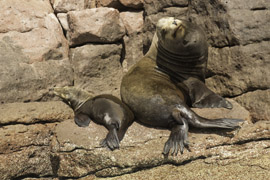
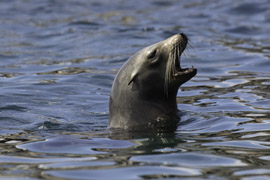
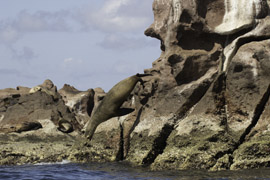
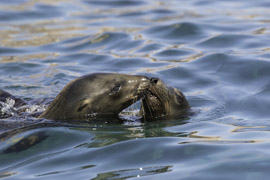
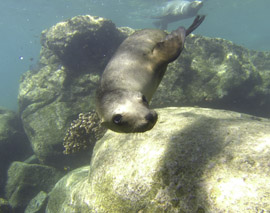
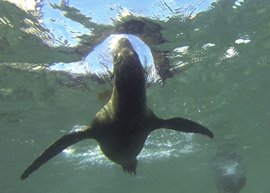
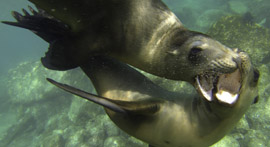
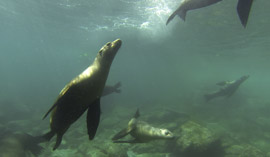
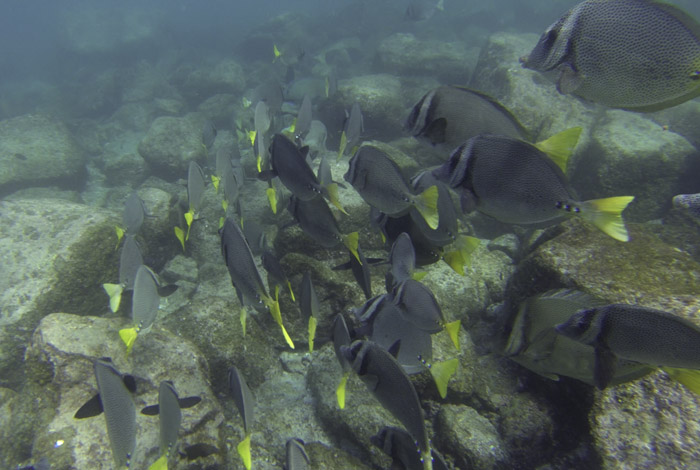
We used our GoPros to film the sea lions, and then captured stills from the video, and the experience, as always, was magical. Wearing wet suits the water was not as cold as expected, and we stayed warm until our camera batteries died. We were using monopods with the GoPro and I always have trouble getting the aiming correct, and missed some great opportunities. Mary is an absolute pro with hers, and she captured numerous sequences -- most of the ones you'll see in this report.
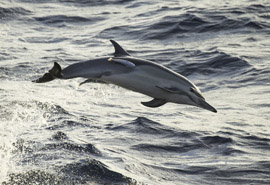 Afterwards we headed south toward Cabo San Lucas and home. That evening we did a Highlights session as a recap and it was interesting to hear the various highlights folks had, from petting a Gray Whale to listening to blows in the dark (where I lost my glasses' lens!), to Rattle-less Rattlesnakes, to swimming with seals. We sailed through the night, docking before dawn for our departure on Feb. 3.
Afterwards we headed south toward Cabo San Lucas and home. That evening we did a Highlights session as a recap and it was interesting to hear the various highlights folks had, from petting a Gray Whale to listening to blows in the dark (where I lost my glasses' lens!), to Rattle-less Rattlesnakes, to swimming with seals. We sailed through the night, docking before dawn for our departure on Feb. 3.
In 2017 we will be returning to the Baja-- as I post this our schedule is still being planned. Contact our office IMMEDIATELY to get on our first contact list.
Trip Report
Baja California
Whales and
Wildlife
Photo Tour
2015
 Breaching Humpback Whale by Tom Base, one of the participants on the trip!
Breaching Humpback Whale by Tom Base, one of the participants on the trip!
 Gray Whale, a screen capture from a GoPro, as the whale visited our skiff.
Gray Whale, a screen capture from a GoPro, as the whale visited our skiff.
 A mother Short-beaked Common Dolphin and baby by Mary Ann.
A mother Short-beaked Common Dolphin and baby by Mary Ann.
It was almost 15 years ago we had last visited Baja California and did a whale/dolphin shoot. That was in film days, and although those two trips were exciting, they were very, very frustrating as well. Photographing porpoising dolphins as they raced across the water, usually just beneath the surface, was a challenge. All of the photographers on those trips wanted to get Dolphins when they cleared the water, but to do so one had to fire the camera shutter before a dolphin's head cleared the water. If you waited until a dolphin cleared the water it was too late, and all you caught was the tail disappeared into the waves. With film, obviously, we had to budget our shooting and hope for the best, and with the ISOs at that time, shooting was very, very tough! Now ... we were doing this same trip with digital, and we were so looking forward to it!
With digital, obviously, we could fire away without worrying about the expense or waste that film entailed. And I am sure, because of that, our shooting this time was extremely rewarding. Obviously we still tried to catch Dolphins as they cleared the water and we were frustrated by looking at the wrong place at the wrong time, but even so, we still had a lot of success - as we did with Humpback Whales breaching, an Orca breaching, spy-hopping Gray Whales, curious Pilot Whales, and more.
We used the whale-watching boat, the Searcher, captained by Art Taylor and a great crew -- Ryan, Aaron, Joe, Dan, and Charles, the same boat we used all those years ago. Our group of 16 was a sub-group of the entire passenger contingent, which included two others from the US and six from the UK, including a lovely honeymooning couple. The group gelled and the non-photographers would do their skiff excursions with Patti, the ship naturalist, while the photographers went with Mary and I in separate skiffs.
Although there may have been a few times when our 500mms would have been handy, or my heavy 200-400mm, for this trip our longest lenses were our 400mm f5.6 lenses, very sharp, and relatively light. Mary borrowed our friend Tom's 100-400mm lens and loved it (she'll be getting one), and I used my 70-300mm for most of my whale shots, sometimes mounted on a 7D for extra reach. Because we were using smaller gear we could carry everything we needed in our Gura Gear Kiboko bags, instead of our usual Bataflae bags. We also used the Gura Gear Chobe bags, which we used to carry our laptops and some camera bodies -- perfect for getting all of our gear onto the planes.
 Because we only carried smaller lenses we used the Really Right Stuff BH40 for all of our shooting. On the boat most of the shooting was hand-held, so we only used our Really Right Stuff tripods on land, but I wouldn't have traveled here without them. For our land-based work, with the unique Rattleless Rattlesnake of Catalina Island and Birds and Seals and Landscapes, a tripod was an essential.
Because we only carried smaller lenses we used the Really Right Stuff BH40 for all of our shooting. On the boat most of the shooting was hand-held, so we only used our Really Right Stuff tripods on land, but I wouldn't have traveled here without them. For our land-based work, with the unique Rattleless Rattlesnake of Catalina Island and Birds and Seals and Landscapes, a tripod was an essential.
As usual, Mary and I and many of our participants used Hoodman CF cards. I was using 64gb cards and Mary was using 32gb cards, and sometimes with the dolphins we used up the cards. In one session, lasting only about an hour, Mary shot over 64 gigs! A couple of photographers only had 8gb cards with them, fearful and hanging on to the old worry that a card might fail and all of their images, if on one card, would be lost. We have never had a Hoodman card fail us, and use the largest cards they have with absolute confidence. If you are worried about card failure you are probably using the wrong cards. Hoodman cards work! With the firmware upgrade for their Steel 3.0 card reader I could download a full card in only a few minutes.
Most of our participants were veterans from many past trips and most of those also had been to our Complete Digital Nature Photo Course or were experienced shooters. Most shot Manual Mode, Spot-metering, which we teach in that course and that exposure method was invaluable on this shoot, as flying birds could be above the water and in the sky, or below the horizon line and against the sea, and program metering modes would be all over the place. On Manual Mode that is not an issue, whether for flying birds, breaching whales, or seals shot from a bouncing skiff. As always, I wish everyone would take that course!
Patti, our naturalist, kept excellent records, keeping track of the various species we saw. This included 12 Marine Mammals, 88 Birds, 4 Reptiles, 13 Invertebrates, and 36 fish. All but two or three of the mammals were satisfactorily photographed, and more than half the birds, although some of the seabirds were too far off and too small a bird for a good shot.

In short, it was an excellent trip and more than met our expectations and hopes. Admittedly, I missed a couple of great shots -- stupidly chimping instead of keeping alert for a breaching Humpback Whale (Tom got it!), using my GoPro for video instead of having my wide-angle ready when a Gray Whale practically put its head into our skiff, and taking a shower too early, when a pod of Orcas suddenly visited our boat. Still, we enjoyed wonderful shooting as you'll see as you go through this report.
One last word first. We are planning on our next trip in 2017, and if you are interested, contact us ASAP and we'll get you on our first contact list. Some of this year's participants are already signed up for the next trip, and we only wish we had time in our 2016 schedule to fit one in next year!
Here's the Trip Report:
Jan. 23. San Diego and heading South
Everyone arrived in plenty of time for a luggage transfer and a lengthy wait until our 8PM boarding of the Searcher and a 10PM departure into the open seas. High winds were forecasted but never materialized and we sailed out of San Diego in soothing calm seas and under a star-filled, cloudless sky. One of our participants tripped as he crossed a street, and thought he may have injured his elbow. He did not – he broke his shoulder instead, and had to cancel the trip. A terrible loss for us, as we would miss his company on the trip.

Jan 24. Mexican Customs, Ensenada Harbor and heading South
 No wind and clear skies. A variety of seabirds passed us throughout the morning, and in mid-morning hours we had a pod or herd of about 300 Pacific Dolphins swimming about. Many breached, flipping onto their backs or sides, and several raced up to our boat to bow-ride. Although we stayed with the dolphins about an hour and we shot constantly, I found I didn’t actually shoot very much – often the dolphins were too far away or would rush in close so quickly that they did so almost unnoticed. Still, it was great fun to watch the dolphins and everyone did manage a few good shots.
No wind and clear skies. A variety of seabirds passed us throughout the morning, and in mid-morning hours we had a pod or herd of about 300 Pacific Dolphins swimming about. Many breached, flipping onto their backs or sides, and several raced up to our boat to bow-ride. Although we stayed with the dolphins about an hour and we shot constantly, I found I didn’t actually shoot very much – often the dolphins were too far away or would rush in close so quickly that they did so almost unnoticed. Still, it was great fun to watch the dolphins and everyone did manage a few good shots.
 We started our shooting, however, right after clearing Mexican customs, where at a rocky outcrop with Pacific swells sweeping in and crashing over the barren rocks we had Elephant Seals, California Sealions, Harbor Seals, Brown Pelicans, a variety of gulls, and Cormorants and Common Loons. Our dolphin encounter soon followed.
We started our shooting, however, right after clearing Mexican customs, where at a rocky outcrop with Pacific swells sweeping in and crashing over the barren rocks we had Elephant Seals, California Sealions, Harbor Seals, Brown Pelicans, a variety of gulls, and Cormorants and Common Loons. Our dolphin encounter soon followed.
We had two different lengthy encounters with migrating Gray Whales, although they did little more than blow spray or sound, displaying their roundish, paddle-like flukes as they sounded. Mid-afternoon we had 7 Orcas, or Killer Whales, that were fishing, and whose presence we often detected by the gulls and shearwaters that would fly about, hover, and land where the whales would surface. Several times we had a large male swim close to our boat, and the shooting was productive.
 At sunset the skies were clear enough for us to see the Green Flash, an optical phenomenon where the sun radiates a green flash – literally, the moment the sun disappears below the horizon line. Several of us tried shooting it but without success. I was using live-view so that I could watch the sky without frying my eyes, and with a 400mm on a 7D, at 560mm, I had a close-up view and could clearly see the flash – a bright flash of gatorade green that I missed shooting. I could see it but doing so it is too late to shoot! We’ll try again tomorrow, weather permitting.
At sunset the skies were clear enough for us to see the Green Flash, an optical phenomenon where the sun radiates a green flash – literally, the moment the sun disappears below the horizon line. Several of us tried shooting it but without success. I was using live-view so that I could watch the sky without frying my eyes, and with a 400mm on a 7D, at 560mm, I had a close-up view and could clearly see the flash – a bright flash of gatorade green that I missed shooting. I could see it but doing so it is too late to shoot! We’ll try again tomorrow, weather permitting.
Jan. 25. West San Benito Island

The day started with our ship cruising into the San Benito Islands where several Northern Elephant Seal haul outs occupy the stone beaches. We landed at 9, and then most of us took a torturous hike along the shoreline, bushwhacking up a ravine, uphill, until we reached a main trail that led, eventually, to a lighthouse. The going was miserable and every step, quite literally, had to be carefully placed to avoid being stabbed and secured by a Cholla cactus pad. The two times I did not watch my footing I was harpooned and the rest of the time I walked in dread, hoping I wasn’t missing a hidden cactus.
When we summited the hill I found we still had 2/3rds of a mile to cover and I elected to join Mary at the elephant seal colony, which gave us two productive hours of shooting. Most of the group continued on what ended up to be nothing more than a forced march, with no time to photograph.
 The one Elephant Seal beach was unsettling, with what appeared to be 50% mortality of babies – dead, rotting, skinless, red carcasses, or fresh ones gleaming ghostly and ghastly white in the surf. I suspect a food shortage has the females leaving the beaches before the babies are weaned, and they starve.
The one Elephant Seal beach was unsettling, with what appeared to be 50% mortality of babies – dead, rotting, skinless, red carcasses, or fresh ones gleaming ghostly and ghastly white in the surf. I suspect a food shortage has the females leaving the beaches before the babies are weaned, and they starve.
Several colorful Side-blotched Lizards scurried about, and I managed some photos. One Osprey plummeted to sea, grabbing a large fish. Peregrine Falcons flew overhead with one tormenting a Red-Tail Hawk.
Towards late afternoon the sea was covered in a flotilla of Red Crabs, little shrimp-like crabs that numbered in the millions. Charles, our chef, extended his GoPro on a long pole and did some interesting video of the two inch crabs floating along, bobbing in the swell.
The skies were just a bit murky for the Green Flash but Cindy caught it this evening. I did not, and most simply missed the Green Flash, which concluded our day.
Jan. 26. San Ignacio Bay
We motored all night to reach the mouth of the San Ignacio Lagoon by 6AM. Waves crashed over hidden sandy shoals, making our entrance into the lagoon nerve-wracking for the captain but we entered without incident. At 9:30 the Kysuma pangas (skiffs) met our boat and we departed on a 3 hour whale cruise just as it began to rain. For the next hour or so it rained, heavily at times, and at least Mary and my rain gear was anything but waterproof, and we were drenched to the skin and cold.
 The whales, however, were great and several spy-hopped, rising out of the water like missiles to survey their surroundings before sinking back and disappearing. We had two or three curious mothers with calves and we had them close enough that we could almost touch them. The weather continually improved and the sun finally came out, beginning to warm and dry us.
The whales, however, were great and several spy-hopped, rising out of the water like missiles to survey their surroundings before sinking back and disappearing. We had two or three curious mothers with calves and we had them close enough that we could almost touch them. The weather continually improved and the sun finally came out, beginning to warm and dry us.
We returned to the boat by 11, and 90 minutes later did the first of two 90 minute excursions. My skiff had little luck on the first leg but did OK on the second, while Mary’s skiff on the second had my skiff captain from the first leg, where we had no luck, but now they did quite well. Indeed, I think everyone did, as well as getting shots of Brandt’s Cormorants, Surf Scoters, and Loons.


Before dinner Brown Pelicans and Royal Terns fished around our boat, capitalizing upon a huge ball of bait fish driven to the surface by predatory fish. We hoped for another Green Flash, but a spit of land blocked the sea’s horizon line and we saw nothing.
 After dinner, our captain turned off the engines and we spent nearly a half hour in the dark, hoping for bioluminescence but strangely there was none, despite the fact that seals swam about the boat. Once, as I leaned over the rail to watch, one of the lenses from my glasses popped out and dropped into the sea! This was the third time I’ve almost lost a lens since I had these glasses, and of course this had to happen when I was overlooking water! Fortunately I had another pair – but I was not happy!
After dinner, our captain turned off the engines and we spent nearly a half hour in the dark, hoping for bioluminescence but strangely there was none, despite the fact that seals swam about the boat. Once, as I leaned over the rail to watch, one of the lenses from my glasses popped out and dropped into the sea! This was the third time I’ve almost lost a lens since I had these glasses, and of course this had to happen when I was overlooking water! Fortunately I had another pair – but I was not happy!
Whales blew, and cloud cover eventually covered the half moon when we turned on the engine and resumed editing before getting to bed.

 Jan. 27. San Ignacio
Jan. 27. San Ignacio
We awoke at 6 for an early breakfast and left for our first panga ride around 7:30. There was some chop but clear skies and no rain.We did four whale excursions today, with two before lunch and two afterwards. 3 of 4 were productive, and only the 3rd was not so. On that one, right after lunch, we had whales, but none came close and we motored about, trying to find a friendly whale, but without success. On the other three excursions however, we had spy-hopping, tail lobbing, and friendly babies, and a few people had the thrill of their lives, actually getting a chance to pet babies.
In the late afternoon there was no wind and the seas at time were pond-like, a mirror of the sky, where the horizon merged seamlessly with the sky as spy-hopping whales surfaced nearby.
Both morning and afternoon we had a friendly mother and baby which both Mary, Judy, and I caught with GoPro cameras. Judy got an incredible sequence – a side view of the baby swimming around the mother, while Mary had a front-view, a bit off-center, showing the same thing. I had one contact where the whale came face on, providing some nice shots.
 The turbidity of the water is such that anything further than 10 feet is lost in the murk, but it was somewhat magical, viewing the video afterward, to have a whale take shape as a vague amorphous darkness, growing in definition and outline until it became a whale. If it came close enough the barnacles and pattern grew clear, and then the whale passed by, its body smoothly gliding below or beside the camera.
The turbidity of the water is such that anything further than 10 feet is lost in the murk, but it was somewhat magical, viewing the video afterward, to have a whale take shape as a vague amorphous darkness, growing in definition and outline until it became a whale. If it came close enough the barnacles and pattern grew clear, and then the whale passed by, its body smoothly gliding below or beside the camera.
Admittedly I missed a lot of shots because I was doing a GoPro rather than a camera, but my goal was to get some underwater shots and I accomplished that. Still, seeing other people’s work I looked with envy at what they caught – particularly spy-hops and some front on views.
Jan. 28. Off the Baja coast heading south
Most of the day was extremely uneventful with a few birds, including a few Red-billed Tropicbirds and a bobby or two, but otherwise we simply cruised south. Several of us occupied part of the time by walking circles around the boat, welcome exercise when ship bound.

However, the last hour of the day was magical and one of the events I most hoped to see on this trip. Around 4:30PM one of the crew spotted 1,000 Short-beaked Common Dolphins ahead of us and we had 45 minutes of pure excitement. We followed the dolphins, turning several times to position the dolphins, and in doing so rocking the boat violently. Twice I went flying, wrenching my bad shoulder one time, and crashing into Michelle another. Later, leaning over the fiberglass splash guard another wave pushed me forward, and I shattered the glass from the holder. Luckily it went sailing out to sea and didn’t hit anyone.
 Mary ended up shooting 64 gigs, and I shot 29. There were a huge number of deletes, with most of the shots catching dolphins as they reentered the water. But, for all the mistakes, we had some great ones. Looking at Mary’s material a second ago, she captured a mother and baby in mid-leap, with the baby shadowing beneath the mother. I caught a sequence early on, one of my best, where a dolphin cleared the water and did a nice arch, with two Remoras, parasitic fish that anchor to the bellies or sides of sharks (usually), attached to the sides of the dolphin. How that fish remains attached with the speed and diving and jumping is a testament to their suction.
Mary ended up shooting 64 gigs, and I shot 29. There were a huge number of deletes, with most of the shots catching dolphins as they reentered the water. But, for all the mistakes, we had some great ones. Looking at Mary’s material a second ago, she captured a mother and baby in mid-leap, with the baby shadowing beneath the mother. I caught a sequence early on, one of my best, where a dolphin cleared the water and did a nice arch, with two Remoras, parasitic fish that anchor to the bellies or sides of sharks (usually), attached to the sides of the dolphin. How that fish remains attached with the speed and diving and jumping is a testament to their suction.



The last light of the day disappeared behind low western clouds and we left the dolphins, exhausted and a bit beaten up from the seas, but elated by what is truly one of the world’s great wildlife spectacles.
Jan. 29. Gorda Banks and Los Frailes
 We spent the morning chasing Humpback Whales off the Gorda Banks. Tom Base had a great shot when one unexpectedly breached right in front of our boat, and he nailed it with a full frame shot. That shot motivated the rest of us to try for more breaching and although more breaching occurred, the breaching was too far away for shots. Photo, left, by Tom Base.
We spent the morning chasing Humpback Whales off the Gorda Banks. Tom Base had a great shot when one unexpectedly breached right in front of our boat, and he nailed it with a full frame shot. That shot motivated the rest of us to try for more breaching and although more breaching occurred, the breaching was too far away for shots. Photo, left, by Tom Base.
In the afternoon we anchored off Los Frailes where we went for a bird walk, hoping to, and finding, Gray Thrashers (an endemic) and Xanthus Hummingbirds (a Baja specialty). In all we saw or photographed about a dozen species, including Hooded Oriole, Loggerhead Shrike, Pyrrhuloxia, Verdin, Cactus Wren, Turkey Vulture, Magnificent Frigatebird, Elegant Tern, Yellow-footed Gull, House Finch, and three species of Dove.




Clockwise, from upper left: Xanthus Hummingbird, Costa Hummingbird,
Turkey Vulture, Gray Thrasher



Pyrrhuloxia, California Gnatcatcher, Hooded Oriole
We met Katy and Mel who had bird feeders and welcomed birders to visit, and there we had the Xanthus Hummer. Some of the group snorkeled, but most of us just went ashore to bird and photograph. The snorkelers enjoyed themselves as well.
Jan. 30. Los Frailes and north into the Sea of Cortez
We started the day back on the beach where people returned, hoping to see the Thrasher and the Hummer. We were successful and saw most of the birds listed above.
 When we left anchor and headed north the weather was poor and some people got seasick and stayed in their cabins. It rained and was dreary, but at the end of the day the weather cleared somewhat and we had another bout with Dolphins – this time, long-beaked Common Dolphins, and later with a small group of Black Fish, or Pilot Whales. They swam close and although the light was getting to be past marginal we had some shooting and very good sightings.
When we left anchor and headed north the weather was poor and some people got seasick and stayed in their cabins. It rained and was dreary, but at the end of the day the weather cleared somewhat and we had another bout with Dolphins – this time, long-beaked Common Dolphins, and later with a small group of Black Fish, or Pilot Whales. They swam close and although the light was getting to be past marginal we had some shooting and very good sightings.
Jan. 31. Punta Colorado and north in the Sea of Cortez
We all awoke pre sunrise to shoot the unusual red sandstone cliffs, but low clouds in the east diluted the effect. The light was low, but the cliffs still glowed in the predawn light and had it been clear, with a dark cloud cover in the west, the scene would have been spectacular.


After breakfast we headed ashore where we walked the cliffs, photographing the colorful eroded rocks, pools, and fossilized shells that marked the different strata.  In the right layer every two inches or less had a shell sticking out, with the strata being about 8 inches deep. A fossilized whale vertebrae and a sea turtle carapace, also entombed, made for wonderful shots and washed up fish skeletons and eels rounded out the shore excursion.
In the right layer every two inches or less had a shell sticking out, with the strata being about 8 inches deep. A fossilized whale vertebrae and a sea turtle carapace, also entombed, made for wonderful shots and washed up fish skeletons and eels rounded out the shore excursion.
Afterwards, most of us snorkeled, and Mary got some OK video of puffer fish with her GoPro, while I had my camera aimed too high and got nothing.
In the afternoon we almost passed on two Humpback Whales that were breaching in the distance, but after counting over 37 breaches we decided to head over. In all 87 breaches occurred, and one was completely out of the water, while I was chimping and missed the shot!
A round-finned Mandela, a type of Sting Ray was leaping beside the boat and we got some shots, but the whale stole the show.

Towards sunset we had still another group of Orcas, 10 total, that was a different group from the ones we had off the Pacific previously. The Orcas were curious and approached the boat several times, and turned upside down and wagged their distinctive tails in the air. It was a great show.

Feb. 1. Santa Catalina Island
We came ashore to one of the prettiest islands, with huge Cordon Cactus and the home to the most unique Rattlesnake species, the Catalina Rattleless Rattlesnake. I found one, a small 14 inch long snake coiled by some grasses. I managed some shots before it took off and before I could call anyone to come see the snake. That may have been a moot point, as the countryside was horrendous, steep, crumbly rock, that threatened to break my ankle every few feet.

When the rest of the crew returned to the ship to either snorkel or do a skiff ride, Mary and I stayed on and looked for another snake, but we were unsuccessful.
Looking for snakes in this habitat is tough. The footing was treacherous, with loose rock and unexpectedly steep slopes, and several times I had to backtrack and try to retrace my steps to find a way back down into the arroyo. We looked very thoroughly but had no luck, and returned to the ship a little disappointed in not having another chance at seeing this snake.


Heermann's Gull, Yellow-footed Gull
After lunch we had an encounter with a Bryde’s Whale, which surfaced close to the boat but offered no real shots. Patti and Cindy chummed, drawing in Heermann’s and Yellow-footed Gulls and while we shot them a large pod or herd of Long-beaked Common Dolphins swam in and we had some good shooting for about 30 minutes before they just disappeared.
 In the last light of afternoon Mary and I decided to get our shower, and while doing so we could hear Art, the Captain, announcing Orcas! We were in almost the exact same spot as yesterday, and we had the same group. This time they were extremely active, tail-slapping and one fully breached, which Judy, Cindy, and Nancy caught, while I just watched! About 30 Short-lobbed Pilot Whales appeared in a tight pod and swam towards the Orcas, who swam off. The Pilot Whales swam close around our boat, but the light was so low I simply stood and watched.
In the last light of afternoon Mary and I decided to get our shower, and while doing so we could hear Art, the Captain, announcing Orcas! We were in almost the exact same spot as yesterday, and we had the same group. This time they were extremely active, tail-slapping and one fully breached, which Judy, Cindy, and Nancy caught, while I just watched! About 30 Short-lobbed Pilot Whales appeared in a tight pod and swam towards the Orcas, who swam off. The Pilot Whales swam close around our boat, but the light was so low I simply stood and watched.
Photo, left, by Tom Base.
Feb. 2. Isla San Jose, Los Islotes, and heading South
We started the day in a mangrove bayou at Isla San Jose, where we looked for a subspecies of Yellow Warbler, a Mangrove Yellow Warbler with a chocolate brown head and neck. We found several and managed a few images. I was using Mary's 7D Mark II (the issues we had with it in Chile [Pumas in Patagonia] we seem to have resolved and the camera worked fine) but Mary keeps her back multi-control wheel on AV and the front one on TV -- EXACTLY opposite of what I do. I find it far easier to roll the shutter with my thumb wheel and keep the aperture set, while firing away, but I can't convince Mary to change. So ... I rolled my thumb wheel and ended up at crazy apertures, and shutter speeds, blowing most of the shots. After that I said the heck with it and changed the camera for my arrangement! Still, I got a few shots, but missed the best ones at too slow a shutter speed.
 We had several species of herons and egret, and a really close and cooperative Eared Grebe that swam by unconcerned. After breakfast, while cruising, we had more Pilot Whales as we headed to Los Islotes for California Sea Lions.
We had several species of herons and egret, and a really close and cooperative Eared Grebe that swam by unconcerned. After breakfast, while cruising, we had more Pilot Whales as we headed to Los Islotes for California Sea Lions.
At the sea stacks we cruised the leeward side of the rocks, photographing the Sea Lions as they swam around our skiffs or lounged on the rocks. We had planned to snorkel, but the water was cold and Mary and I almost opted out, until we did the skiff ride and saw so much action. So we snorkeled, and it was fantastic.









We used our GoPros to film the sea lions, and then captured stills from the video, and the experience, as always, was magical. Wearing wet suits the water was not as cold as expected, and we stayed warm until our camera batteries died. We were using monopods with the GoPro and I always have trouble getting the aiming correct, and missed some great opportunities. Mary is an absolute pro with hers, and she captured numerous sequences -- most of the ones you'll see in this report.
 Afterwards we headed south toward Cabo San Lucas and home. That evening we did a Highlights session as a recap and it was interesting to hear the various highlights folks had, from petting a Gray Whale to listening to blows in the dark (where I lost my glasses' lens!), to Rattle-less Rattlesnakes, to swimming with seals. We sailed through the night, docking before dawn for our departure on Feb. 3.
Afterwards we headed south toward Cabo San Lucas and home. That evening we did a Highlights session as a recap and it was interesting to hear the various highlights folks had, from petting a Gray Whale to listening to blows in the dark (where I lost my glasses' lens!), to Rattle-less Rattlesnakes, to swimming with seals. We sailed through the night, docking before dawn for our departure on Feb. 3.
In 2017 we will be returning to the Baja-- as I post this our schedule is still being planned. Contact our office IMMEDIATELY to get on our first contact list.
Trip Report
Baja California
Whales and
Wildlife
Photo Tour
2015
 Breaching Humpback Whale by Tom Base, one of the participants on the trip!
Breaching Humpback Whale by Tom Base, one of the participants on the trip!
 Gray Whale, a screen capture from a GoPro, as the whale visited our skiff.
Gray Whale, a screen capture from a GoPro, as the whale visited our skiff.
 A mother Short-beaked Common Dolphin and baby by Mary Ann.
A mother Short-beaked Common Dolphin and baby by Mary Ann.
It was almost 15 years ago we had last visited Baja California and did a whale/dolphin shoot. That was in film days, and although those two trips were exciting, they were very, very frustrating as well. Photographing porpoising dolphins as they raced across the water, usually just beneath the surface, was a challenge. All of the photographers on those trips wanted to get Dolphins when they cleared the water, but to do so one had to fire the camera shutter before a dolphin's head cleared the water. If you waited until a dolphin cleared the water it was too late, and all you caught was the tail disappeared into the waves. With film, obviously, we had to budget our shooting and hope for the best, and with the ISOs at that time, shooting was very, very tough! Now ... we were doing this same trip with digital, and we were so looking forward to it!
With digital, obviously, we could fire away without worrying about the expense or waste that film entailed. And I am sure, because of that, our shooting this time was extremely rewarding. Obviously we still tried to catch Dolphins as they cleared the water and we were frustrated by looking at the wrong place at the wrong time, but even so, we still had a lot of success - as we did with Humpback Whales breaching, an Orca breaching, spy-hopping Gray Whales, curious Pilot Whales, and more.
We used the whale-watching boat, the Searcher, captained by Art Taylor and a great crew -- Ryan, Aaron, Joe, Dan, and Charles, the same boat we used all those years ago. Our group of 16 was a sub-group of the entire passenger contingent, which included two others from the US and six from the UK, including a lovely honeymooning couple. The group gelled and the non-photographers would do their skiff excursions with Patti, the ship naturalist, while the photographers went with Mary and I in separate skiffs.
Although there may have been a few times when our 500mms would have been handy, or my heavy 200-400mm, for this trip our longest lenses were our 400mm f5.6 lenses, very sharp, and relatively light. Mary borrowed our friend Tom's 100-400mm lens and loved it (she'll be getting one), and I used my 70-300mm for most of my whale shots, sometimes mounted on a 7D for extra reach. Because we were using smaller gear we could carry everything we needed in our Gura Gear Kiboko bags, instead of our usual Bataflae bags. We also used the Gura Gear Chobe bags, which we used to carry our laptops and some camera bodies -- perfect for getting all of our gear onto the planes.
 Because we only carried smaller lenses we used the Really Right Stuff BH40 for all of our shooting. On the boat most of the shooting was hand-held, so we only used our Really Right Stuff tripods on land, but I wouldn't have traveled here without them. For our land-based work, with the unique Rattleless Rattlesnake of Catalina Island and Birds and Seals and Landscapes, a tripod was an essential.
Because we only carried smaller lenses we used the Really Right Stuff BH40 for all of our shooting. On the boat most of the shooting was hand-held, so we only used our Really Right Stuff tripods on land, but I wouldn't have traveled here without them. For our land-based work, with the unique Rattleless Rattlesnake of Catalina Island and Birds and Seals and Landscapes, a tripod was an essential.
As usual, Mary and I and many of our participants used Hoodman CF cards. I was using 64gb cards and Mary was using 32gb cards, and sometimes with the dolphins we used up the cards. In one session, lasting only about an hour, Mary shot over 64 gigs! A couple of photographers only had 8gb cards with them, fearful and hanging on to the old worry that a card might fail and all of their images, if on one card, would be lost. We have never had a Hoodman card fail us, and use the largest cards they have with absolute confidence. If you are worried about card failure you are probably using the wrong cards. Hoodman cards work! With the firmware upgrade for their Steel 3.0 card reader I could download a full card in only a few minutes.
Most of our participants were veterans from many past trips and most of those also had been to our Complete Digital Nature Photo Course or were experienced shooters. Most shot Manual Mode, Spot-metering, which we teach in that course and that exposure method was invaluable on this shoot, as flying birds could be above the water and in the sky, or below the horizon line and against the sea, and program metering modes would be all over the place. On Manual Mode that is not an issue, whether for flying birds, breaching whales, or seals shot from a bouncing skiff. As always, I wish everyone would take that course!
Patti, our naturalist, kept excellent records, keeping track of the various species we saw. This included 12 Marine Mammals, 88 Birds, 4 Reptiles, 13 Invertebrates, and 36 fish. All but two or three of the mammals were satisfactorily photographed, and more than half the birds, although some of the seabirds were too far off and too small a bird for a good shot.

In short, it was an excellent trip and more than met our expectations and hopes. Admittedly, I missed a couple of great shots -- stupidly chimping instead of keeping alert for a breaching Humpback Whale (Tom got it!), using my GoPro for video instead of having my wide-angle ready when a Gray Whale practically put its head into our skiff, and taking a shower too early, when a pod of Orcas suddenly visited our boat. Still, we enjoyed wonderful shooting as you'll see as you go through this report.
One last word first. We are planning on our next trip in 2017, and if you are interested, contact us ASAP and we'll get you on our first contact list. Some of this year's participants are already signed up for the next trip, and we only wish we had time in our 2016 schedule to fit one in next year!
Here's the Trip Report:
Jan. 23. San Diego and heading South
Everyone arrived in plenty of time for a luggage transfer and a lengthy wait until our 8PM boarding of the Searcher and a 10PM departure into the open seas. High winds were forecasted but never materialized and we sailed out of San Diego in soothing calm seas and under a star-filled, cloudless sky. One of our participants tripped as he crossed a street, and thought he may have injured his elbow. He did not – he broke his shoulder instead, and had to cancel the trip. A terrible loss for us, as we would miss his company on the trip.

Jan 24. Mexican Customs, Ensenada Harbor and heading South
 No wind and clear skies. A variety of seabirds passed us throughout the morning, and in mid-morning hours we had a pod or herd of about 300 Pacific Dolphins swimming about. Many breached, flipping onto their backs or sides, and several raced up to our boat to bow-ride. Although we stayed with the dolphins about an hour and we shot constantly, I found I didn’t actually shoot very much – often the dolphins were too far away or would rush in close so quickly that they did so almost unnoticed. Still, it was great fun to watch the dolphins and everyone did manage a few good shots.
No wind and clear skies. A variety of seabirds passed us throughout the morning, and in mid-morning hours we had a pod or herd of about 300 Pacific Dolphins swimming about. Many breached, flipping onto their backs or sides, and several raced up to our boat to bow-ride. Although we stayed with the dolphins about an hour and we shot constantly, I found I didn’t actually shoot very much – often the dolphins were too far away or would rush in close so quickly that they did so almost unnoticed. Still, it was great fun to watch the dolphins and everyone did manage a few good shots.
 We started our shooting, however, right after clearing Mexican customs, where at a rocky outcrop with Pacific swells sweeping in and crashing over the barren rocks we had Elephant Seals, California Sealions, Harbor Seals, Brown Pelicans, a variety of gulls, and Cormorants and Common Loons. Our dolphin encounter soon followed.
We started our shooting, however, right after clearing Mexican customs, where at a rocky outcrop with Pacific swells sweeping in and crashing over the barren rocks we had Elephant Seals, California Sealions, Harbor Seals, Brown Pelicans, a variety of gulls, and Cormorants and Common Loons. Our dolphin encounter soon followed.
We had two different lengthy encounters with migrating Gray Whales, although they did little more than blow spray or sound, displaying their roundish, paddle-like flukes as they sounded. Mid-afternoon we had 7 Orcas, or Killer Whales, that were fishing, and whose presence we often detected by the gulls and shearwaters that would fly about, hover, and land where the whales would surface. Several times we had a large male swim close to our boat, and the shooting was productive.
 At sunset the skies were clear enough for us to see the Green Flash, an optical phenomenon where the sun radiates a green flash – literally, the moment the sun disappears below the horizon line. Several of us tried shooting it but without success. I was using live-view so that I could watch the sky without frying my eyes, and with a 400mm on a 7D, at 560mm, I had a close-up view and could clearly see the flash – a bright flash of gatorade green that I missed shooting. I could see it but doing so it is too late to shoot! We’ll try again tomorrow, weather permitting.
At sunset the skies were clear enough for us to see the Green Flash, an optical phenomenon where the sun radiates a green flash – literally, the moment the sun disappears below the horizon line. Several of us tried shooting it but without success. I was using live-view so that I could watch the sky without frying my eyes, and with a 400mm on a 7D, at 560mm, I had a close-up view and could clearly see the flash – a bright flash of gatorade green that I missed shooting. I could see it but doing so it is too late to shoot! We’ll try again tomorrow, weather permitting.
Jan. 25. West San Benito Island

The day started with our ship cruising into the San Benito Islands where several Northern Elephant Seal haul outs occupy the stone beaches. We landed at 9, and then most of us took a torturous hike along the shoreline, bushwhacking up a ravine, uphill, until we reached a main trail that led, eventually, to a lighthouse. The going was miserable and every step, quite literally, had to be carefully placed to avoid being stabbed and secured by a Cholla cactus pad. The two times I did not watch my footing I was harpooned and the rest of the time I walked in dread, hoping I wasn’t missing a hidden cactus.
When we summited the hill I found we still had 2/3rds of a mile to cover and I elected to join Mary at the elephant seal colony, which gave us two productive hours of shooting. Most of the group continued on what ended up to be nothing more than a forced march, with no time to photograph.
 The one Elephant Seal beach was unsettling, with what appeared to be 50% mortality of babies – dead, rotting, skinless, red carcasses, or fresh ones gleaming ghostly and ghastly white in the surf. I suspect a food shortage has the females leaving the beaches before the babies are weaned, and they starve.
The one Elephant Seal beach was unsettling, with what appeared to be 50% mortality of babies – dead, rotting, skinless, red carcasses, or fresh ones gleaming ghostly and ghastly white in the surf. I suspect a food shortage has the females leaving the beaches before the babies are weaned, and they starve.
Several colorful Side-blotched Lizards scurried about, and I managed some photos. One Osprey plummeted to sea, grabbing a large fish. Peregrine Falcons flew overhead with one tormenting a Red-Tail Hawk.
Towards late afternoon the sea was covered in a flotilla of Red Crabs, little shrimp-like crabs that numbered in the millions. Charles, our chef, extended his GoPro on a long pole and did some interesting video of the two inch crabs floating along, bobbing in the swell.
The skies were just a bit murky for the Green Flash but Cindy caught it this evening. I did not, and most simply missed the Green Flash, which concluded our day.
Jan. 26. San Ignacio Bay
We motored all night to reach the mouth of the San Ignacio Lagoon by 6AM. Waves crashed over hidden sandy shoals, making our entrance into the lagoon nerve-wracking for the captain but we entered without incident. At 9:30 the Kysuma pangas (skiffs) met our boat and we departed on a 3 hour whale cruise just as it began to rain. For the next hour or so it rained, heavily at times, and at least Mary and my rain gear was anything but waterproof, and we were drenched to the skin and cold.
 The whales, however, were great and several spy-hopped, rising out of the water like missiles to survey their surroundings before sinking back and disappearing. We had two or three curious mothers with calves and we had them close enough that we could almost touch them. The weather continually improved and the sun finally came out, beginning to warm and dry us.
The whales, however, were great and several spy-hopped, rising out of the water like missiles to survey their surroundings before sinking back and disappearing. We had two or three curious mothers with calves and we had them close enough that we could almost touch them. The weather continually improved and the sun finally came out, beginning to warm and dry us.
We returned to the boat by 11, and 90 minutes later did the first of two 90 minute excursions. My skiff had little luck on the first leg but did OK on the second, while Mary’s skiff on the second had my skiff captain from the first leg, where we had no luck, but now they did quite well. Indeed, I think everyone did, as well as getting shots of Brandt’s Cormorants, Surf Scoters, and Loons.


Before dinner Brown Pelicans and Royal Terns fished around our boat, capitalizing upon a huge ball of bait fish driven to the surface by predatory fish. We hoped for another Green Flash, but a spit of land blocked the sea’s horizon line and we saw nothing.
 After dinner, our captain turned off the engines and we spent nearly a half hour in the dark, hoping for bioluminescence but strangely there was none, despite the fact that seals swam about the boat. Once, as I leaned over the rail to watch, one of the lenses from my glasses popped out and dropped into the sea! This was the third time I’ve almost lost a lens since I had these glasses, and of course this had to happen when I was overlooking water! Fortunately I had another pair – but I was not happy!
After dinner, our captain turned off the engines and we spent nearly a half hour in the dark, hoping for bioluminescence but strangely there was none, despite the fact that seals swam about the boat. Once, as I leaned over the rail to watch, one of the lenses from my glasses popped out and dropped into the sea! This was the third time I’ve almost lost a lens since I had these glasses, and of course this had to happen when I was overlooking water! Fortunately I had another pair – but I was not happy!
Whales blew, and cloud cover eventually covered the half moon when we turned on the engine and resumed editing before getting to bed.

 Jan. 27. San Ignacio
Jan. 27. San Ignacio
We awoke at 6 for an early breakfast and left for our first panga ride around 7:30. There was some chop but clear skies and no rain.We did four whale excursions today, with two before lunch and two afterwards. 3 of 4 were productive, and only the 3rd was not so. On that one, right after lunch, we had whales, but none came close and we motored about, trying to find a friendly whale, but without success. On the other three excursions however, we had spy-hopping, tail lobbing, and friendly babies, and a few people had the thrill of their lives, actually getting a chance to pet babies.
In the late afternoon there was no wind and the seas at time were pond-like, a mirror of the sky, where the horizon merged seamlessly with the sky as spy-hopping whales surfaced nearby.
Both morning and afternoon we had a friendly mother and baby which both Mary, Judy, and I caught with GoPro cameras. Judy got an incredible sequence – a side view of the baby swimming around the mother, while Mary had a front-view, a bit off-center, showing the same thing. I had one contact where the whale came face on, providing some nice shots.
 The turbidity of the water is such that anything further than 10 feet is lost in the murk, but it was somewhat magical, viewing the video afterward, to have a whale take shape as a vague amorphous darkness, growing in definition and outline until it became a whale. If it came close enough the barnacles and pattern grew clear, and then the whale passed by, its body smoothly gliding below or beside the camera.
The turbidity of the water is such that anything further than 10 feet is lost in the murk, but it was somewhat magical, viewing the video afterward, to have a whale take shape as a vague amorphous darkness, growing in definition and outline until it became a whale. If it came close enough the barnacles and pattern grew clear, and then the whale passed by, its body smoothly gliding below or beside the camera.
Admittedly I missed a lot of shots because I was doing a GoPro rather than a camera, but my goal was to get some underwater shots and I accomplished that. Still, seeing other people’s work I looked with envy at what they caught – particularly spy-hops and some front on views.
Jan. 28. Off the Baja coast heading south
Most of the day was extremely uneventful with a few birds, including a few Red-billed Tropicbirds and a bobby or two, but otherwise we simply cruised south. Several of us occupied part of the time by walking circles around the boat, welcome exercise when ship bound.

However, the last hour of the day was magical and one of the events I most hoped to see on this trip. Around 4:30PM one of the crew spotted 1,000 Short-beaked Common Dolphins ahead of us and we had 45 minutes of pure excitement. We followed the dolphins, turning several times to position the dolphins, and in doing so rocking the boat violently. Twice I went flying, wrenching my bad shoulder one time, and crashing into Michelle another. Later, leaning over the fiberglass splash guard another wave pushed me forward, and I shattered the glass from the holder. Luckily it went sailing out to sea and didn’t hit anyone.
 Mary ended up shooting 64 gigs, and I shot 29. There were a huge number of deletes, with most of the shots catching dolphins as they reentered the water. But, for all the mistakes, we had some great ones. Looking at Mary’s material a second ago, she captured a mother and baby in mid-leap, with the baby shadowing beneath the mother. I caught a sequence early on, one of my best, where a dolphin cleared the water and did a nice arch, with two Remoras, parasitic fish that anchor to the bellies or sides of sharks (usually), attached to the sides of the dolphin. How that fish remains attached with the speed and diving and jumping is a testament to their suction.
Mary ended up shooting 64 gigs, and I shot 29. There were a huge number of deletes, with most of the shots catching dolphins as they reentered the water. But, for all the mistakes, we had some great ones. Looking at Mary’s material a second ago, she captured a mother and baby in mid-leap, with the baby shadowing beneath the mother. I caught a sequence early on, one of my best, where a dolphin cleared the water and did a nice arch, with two Remoras, parasitic fish that anchor to the bellies or sides of sharks (usually), attached to the sides of the dolphin. How that fish remains attached with the speed and diving and jumping is a testament to their suction.



The last light of the day disappeared behind low western clouds and we left the dolphins, exhausted and a bit beaten up from the seas, but elated by what is truly one of the world’s great wildlife spectacles.
Jan. 29. Gorda Banks and Los Frailes
 We spent the morning chasing Humpback Whales off the Gorda Banks. Tom Base had a great shot when one unexpectedly breached right in front of our boat, and he nailed it with a full frame shot. That shot motivated the rest of us to try for more breaching and although more breaching occurred, the breaching was too far away for shots. Photo, left, by Tom Base.
We spent the morning chasing Humpback Whales off the Gorda Banks. Tom Base had a great shot when one unexpectedly breached right in front of our boat, and he nailed it with a full frame shot. That shot motivated the rest of us to try for more breaching and although more breaching occurred, the breaching was too far away for shots. Photo, left, by Tom Base.
In the afternoon we anchored off Los Frailes where we went for a bird walk, hoping to, and finding, Gray Thrashers (an endemic) and Xanthus Hummingbirds (a Baja specialty). In all we saw or photographed about a dozen species, including Hooded Oriole, Loggerhead Shrike, Pyrrhuloxia, Verdin, Cactus Wren, Turkey Vulture, Magnificent Frigatebird, Elegant Tern, Yellow-footed Gull, House Finch, and three species of Dove.




Clockwise, from upper left: Xanthus Hummingbird, Costa Hummingbird,
Turkey Vulture, Gray Thrasher



Pyrrhuloxia, California Gnatcatcher, Hooded Oriole
We met Katy and Mel who had bird feeders and welcomed birders to visit, and there we had the Xanthus Hummer. Some of the group snorkeled, but most of us just went ashore to bird and photograph. The snorkelers enjoyed themselves as well.
Jan. 30. Los Frailes and north into the Sea of Cortez
We started the day back on the beach where people returned, hoping to see the Thrasher and the Hummer. We were successful and saw most of the birds listed above.
 When we left anchor and headed north the weather was poor and some people got seasick and stayed in their cabins. It rained and was dreary, but at the end of the day the weather cleared somewhat and we had another bout with Dolphins – this time, long-beaked Common Dolphins, and later with a small group of Black Fish, or Pilot Whales. They swam close and although the light was getting to be past marginal we had some shooting and very good sightings.
When we left anchor and headed north the weather was poor and some people got seasick and stayed in their cabins. It rained and was dreary, but at the end of the day the weather cleared somewhat and we had another bout with Dolphins – this time, long-beaked Common Dolphins, and later with a small group of Black Fish, or Pilot Whales. They swam close and although the light was getting to be past marginal we had some shooting and very good sightings.
Jan. 31. Punta Colorado and north in the Sea of Cortez
We all awoke pre sunrise to shoot the unusual red sandstone cliffs, but low clouds in the east diluted the effect. The light was low, but the cliffs still glowed in the predawn light and had it been clear, with a dark cloud cover in the west, the scene would have been spectacular.


After breakfast we headed ashore where we walked the cliffs, photographing the colorful eroded rocks, pools, and fossilized shells that marked the different strata.  In the right layer every two inches or less had a shell sticking out, with the strata being about 8 inches deep. A fossilized whale vertebrae and a sea turtle carapace, also entombed, made for wonderful shots and washed up fish skeletons and eels rounded out the shore excursion.
In the right layer every two inches or less had a shell sticking out, with the strata being about 8 inches deep. A fossilized whale vertebrae and a sea turtle carapace, also entombed, made for wonderful shots and washed up fish skeletons and eels rounded out the shore excursion.
Afterwards, most of us snorkeled, and Mary got some OK video of puffer fish with her GoPro, while I had my camera aimed too high and got nothing.
In the afternoon we almost passed on two Humpback Whales that were breaching in the distance, but after counting over 37 breaches we decided to head over. In all 87 breaches occurred, and one was completely out of the water, while I was chimping and missed the shot!
A round-finned Mandela, a type of Sting Ray was leaping beside the boat and we got some shots, but the whale stole the show.

Towards sunset we had still another group of Orcas, 10 total, that was a different group from the ones we had off the Pacific previously. The Orcas were curious and approached the boat several times, and turned upside down and wagged their distinctive tails in the air. It was a great show.

Feb. 1. Santa Catalina Island
We came ashore to one of the prettiest islands, with huge Cordon Cactus and the home to the most unique Rattlesnake species, the Catalina Rattleless Rattlesnake. I found one, a small 14 inch long snake coiled by some grasses. I managed some shots before it took off and before I could call anyone to come see the snake. That may have been a moot point, as the countryside was horrendous, steep, crumbly rock, that threatened to break my ankle every few feet.

When the rest of the crew returned to the ship to either snorkel or do a skiff ride, Mary and I stayed on and looked for another snake, but we were unsuccessful.
Looking for snakes in this habitat is tough. The footing was treacherous, with loose rock and unexpectedly steep slopes, and several times I had to backtrack and try to retrace my steps to find a way back down into the arroyo. We looked very thoroughly but had no luck, and returned to the ship a little disappointed in not having another chance at seeing this snake.


Heermann's Gull, Yellow-footed Gull
After lunch we had an encounter with a Bryde’s Whale, which surfaced close to the boat but offered no real shots. Patti and Cindy chummed, drawing in Heermann’s and Yellow-footed Gulls and while we shot them a large pod or herd of Long-beaked Common Dolphins swam in and we had some good shooting for about 30 minutes before they just disappeared.
 In the last light of afternoon Mary and I decided to get our shower, and while doing so we could hear Art, the Captain, announcing Orcas! We were in almost the exact same spot as yesterday, and we had the same group. This time they were extremely active, tail-slapping and one fully breached, which Judy, Cindy, and Nancy caught, while I just watched! About 30 Short-lobbed Pilot Whales appeared in a tight pod and swam towards the Orcas, who swam off. The Pilot Whales swam close around our boat, but the light was so low I simply stood and watched.
In the last light of afternoon Mary and I decided to get our shower, and while doing so we could hear Art, the Captain, announcing Orcas! We were in almost the exact same spot as yesterday, and we had the same group. This time they were extremely active, tail-slapping and one fully breached, which Judy, Cindy, and Nancy caught, while I just watched! About 30 Short-lobbed Pilot Whales appeared in a tight pod and swam towards the Orcas, who swam off. The Pilot Whales swam close around our boat, but the light was so low I simply stood and watched.
Photo, left, by Tom Base.
Feb. 2. Isla San Jose, Los Islotes, and heading South
We started the day in a mangrove bayou at Isla San Jose, where we looked for a subspecies of Yellow Warbler, a Mangrove Yellow Warbler with a chocolate brown head and neck. We found several and managed a few images. I was using Mary's 7D Mark II (the issues we had with it in Chile [Pumas in Patagonia] we seem to have resolved and the camera worked fine) but Mary keeps her back multi-control wheel on AV and the front one on TV -- EXACTLY opposite of what I do. I find it far easier to roll the shutter with my thumb wheel and keep the aperture set, while firing away, but I can't convince Mary to change. So ... I rolled my thumb wheel and ended up at crazy apertures, and shutter speeds, blowing most of the shots. After that I said the heck with it and changed the camera for my arrangement! Still, I got a few shots, but missed the best ones at too slow a shutter speed.
 We had several species of herons and egret, and a really close and cooperative Eared Grebe that swam by unconcerned. After breakfast, while cruising, we had more Pilot Whales as we headed to Los Islotes for California Sea Lions.
We had several species of herons and egret, and a really close and cooperative Eared Grebe that swam by unconcerned. After breakfast, while cruising, we had more Pilot Whales as we headed to Los Islotes for California Sea Lions.
At the sea stacks we cruised the leeward side of the rocks, photographing the Sea Lions as they swam around our skiffs or lounged on the rocks. We had planned to snorkel, but the water was cold and Mary and I almost opted out, until we did the skiff ride and saw so much action. So we snorkeled, and it was fantastic.









We used our GoPros to film the sea lions, and then captured stills from the video, and the experience, as always, was magical. Wearing wet suits the water was not as cold as expected, and we stayed warm until our camera batteries died. We were using monopods with the GoPro and I always have trouble getting the aiming correct, and missed some great opportunities. Mary is an absolute pro with hers, and she captured numerous sequences -- most of the ones you'll see in this report.
 Afterwards we headed south toward Cabo San Lucas and home. That evening we did a Highlights session as a recap and it was interesting to hear the various highlights folks had, from petting a Gray Whale to listening to blows in the dark (where I lost my glasses' lens!), to Rattle-less Rattlesnakes, to swimming with seals. We sailed through the night, docking before dawn for our departure on Feb. 3.
Afterwards we headed south toward Cabo San Lucas and home. That evening we did a Highlights session as a recap and it was interesting to hear the various highlights folks had, from petting a Gray Whale to listening to blows in the dark (where I lost my glasses' lens!), to Rattle-less Rattlesnakes, to swimming with seals. We sailed through the night, docking before dawn for our departure on Feb. 3.
In 2017 we will be returning to the Baja-- as I post this our schedule is still being planned. Contact our office IMMEDIATELY to get on our first contact list.
Trip Report
Baja California
Whales and
Wildlife
Photo Tour
2015
 Breaching Humpback Whale by Tom Base, one of the participants on the trip!
Breaching Humpback Whale by Tom Base, one of the participants on the trip!
 Gray Whale, a screen capture from a GoPro, as the whale visited our skiff.
Gray Whale, a screen capture from a GoPro, as the whale visited our skiff.
 A mother Short-beaked Common Dolphin and baby by Mary Ann.
A mother Short-beaked Common Dolphin and baby by Mary Ann.
It was almost 15 years ago we had last visited Baja California and did a whale/dolphin shoot. That was in film days, and although those two trips were exciting, they were very, very frustrating as well. Photographing porpoising dolphins as they raced across the water, usually just beneath the surface, was a challenge. All of the photographers on those trips wanted to get Dolphins when they cleared the water, but to do so one had to fire the camera shutter before a dolphin's head cleared the water. If you waited until a dolphin cleared the water it was too late, and all you caught was the tail disappeared into the waves. With film, obviously, we had to budget our shooting and hope for the best, and with the ISOs at that time, shooting was very, very tough! Now ... we were doing this same trip with digital, and we were so looking forward to it!
With digital, obviously, we could fire away without worrying about the expense or waste that film entailed. And I am sure, because of that, our shooting this time was extremely rewarding. Obviously we still tried to catch Dolphins as they cleared the water and we were frustrated by looking at the wrong place at the wrong time, but even so, we still had a lot of success - as we did with Humpback Whales breaching, an Orca breaching, spy-hopping Gray Whales, curious Pilot Whales, and more.
We used the whale-watching boat, the Searcher, captained by Art Taylor and a great crew -- Ryan, Aaron, Joe, Dan, and Charles, the same boat we used all those years ago. Our group of 16 was a sub-group of the entire passenger contingent, which included two others from the US and six from the UK, including a lovely honeymooning couple. The group gelled and the non-photographers would do their skiff excursions with Patti, the ship naturalist, while the photographers went with Mary and I in separate skiffs.
Although there may have been a few times when our 500mms would have been handy, or my heavy 200-400mm, for this trip our longest lenses were our 400mm f5.6 lenses, very sharp, and relatively light. Mary borrowed our friend Tom's 100-400mm lens and loved it (she'll be getting one), and I used my 70-300mm for most of my whale shots, sometimes mounted on a 7D for extra reach. Because we were using smaller gear we could carry everything we needed in our Gura Gear Kiboko bags, instead of our usual Bataflae bags. We also used the Gura Gear Chobe bags, which we used to carry our laptops and some camera bodies -- perfect for getting all of our gear onto the planes.
 Because we only carried smaller lenses we used the Really Right Stuff BH40 for all of our shooting. On the boat most of the shooting was hand-held, so we only used our Really Right Stuff tripods on land, but I wouldn't have traveled here without them. For our land-based work, with the unique Rattleless Rattlesnake of Catalina Island and Birds and Seals and Landscapes, a tripod was an essential.
Because we only carried smaller lenses we used the Really Right Stuff BH40 for all of our shooting. On the boat most of the shooting was hand-held, so we only used our Really Right Stuff tripods on land, but I wouldn't have traveled here without them. For our land-based work, with the unique Rattleless Rattlesnake of Catalina Island and Birds and Seals and Landscapes, a tripod was an essential.
As usual, Mary and I and many of our participants used Hoodman CF cards. I was using 64gb cards and Mary was using 32gb cards, and sometimes with the dolphins we used up the cards. In one session, lasting only about an hour, Mary shot over 64 gigs! A couple of photographers only had 8gb cards with them, fearful and hanging on to the old worry that a card might fail and all of their images, if on one card, would be lost. We have never had a Hoodman card fail us, and use the largest cards they have with absolute confidence. If you are worried about card failure you are probably using the wrong cards. Hoodman cards work! With the firmware upgrade for their Steel 3.0 card reader I could download a full card in only a few minutes.
Most of our participants were veterans from many past trips and most of those also had been to our Complete Digital Nature Photo Course or were experienced shooters. Most shot Manual Mode, Spot-metering, which we teach in that course and that exposure method was invaluable on this shoot, as flying birds could be above the water and in the sky, or below the horizon line and against the sea, and program metering modes would be all over the place. On Manual Mode that is not an issue, whether for flying birds, breaching whales, or seals shot from a bouncing skiff. As always, I wish everyone would take that course!
Patti, our naturalist, kept excellent records, keeping track of the various species we saw. This included 12 Marine Mammals, 88 Birds, 4 Reptiles, 13 Invertebrates, and 36 fish. All but two or three of the mammals were satisfactorily photographed, and more than half the birds, although some of the seabirds were too far off and too small a bird for a good shot.

In short, it was an excellent trip and more than met our expectations and hopes. Admittedly, I missed a couple of great shots -- stupidly chimping instead of keeping alert for a breaching Humpback Whale (Tom got it!), using my GoPro for video instead of having my wide-angle ready when a Gray Whale practically put its head into our skiff, and taking a shower too early, when a pod of Orcas suddenly visited our boat. Still, we enjoyed wonderful shooting as you'll see as you go through this report.
One last word first. We are planning on our next trip in 2017, and if you are interested, contact us ASAP and we'll get you on our first contact list. Some of this year's participants are already signed up for the next trip, and we only wish we had time in our 2016 schedule to fit one in next year!
Here's the Trip Report:
Jan. 23. San Diego and heading South
Everyone arrived in plenty of time for a luggage transfer and a lengthy wait until our 8PM boarding of the Searcher and a 10PM departure into the open seas. High winds were forecasted but never materialized and we sailed out of San Diego in soothing calm seas and under a star-filled, cloudless sky. One of our participants tripped as he crossed a street, and thought he may have injured his elbow. He did not – he broke his shoulder instead, and had to cancel the trip. A terrible loss for us, as we would miss his company on the trip.

Jan 24. Mexican Customs, Ensenada Harbor and heading South
 No wind and clear skies. A variety of seabirds passed us throughout the morning, and in mid-morning hours we had a pod or herd of about 300 Pacific Dolphins swimming about. Many breached, flipping onto their backs or sides, and several raced up to our boat to bow-ride. Although we stayed with the dolphins about an hour and we shot constantly, I found I didn’t actually shoot very much – often the dolphins were too far away or would rush in close so quickly that they did so almost unnoticed. Still, it was great fun to watch the dolphins and everyone did manage a few good shots.
No wind and clear skies. A variety of seabirds passed us throughout the morning, and in mid-morning hours we had a pod or herd of about 300 Pacific Dolphins swimming about. Many breached, flipping onto their backs or sides, and several raced up to our boat to bow-ride. Although we stayed with the dolphins about an hour and we shot constantly, I found I didn’t actually shoot very much – often the dolphins were too far away or would rush in close so quickly that they did so almost unnoticed. Still, it was great fun to watch the dolphins and everyone did manage a few good shots.
 We started our shooting, however, right after clearing Mexican customs, where at a rocky outcrop with Pacific swells sweeping in and crashing over the barren rocks we had Elephant Seals, California Sealions, Harbor Seals, Brown Pelicans, a variety of gulls, and Cormorants and Common Loons. Our dolphin encounter soon followed.
We started our shooting, however, right after clearing Mexican customs, where at a rocky outcrop with Pacific swells sweeping in and crashing over the barren rocks we had Elephant Seals, California Sealions, Harbor Seals, Brown Pelicans, a variety of gulls, and Cormorants and Common Loons. Our dolphin encounter soon followed.
We had two different lengthy encounters with migrating Gray Whales, although they did little more than blow spray or sound, displaying their roundish, paddle-like flukes as they sounded. Mid-afternoon we had 7 Orcas, or Killer Whales, that were fishing, and whose presence we often detected by the gulls and shearwaters that would fly about, hover, and land where the whales would surface. Several times we had a large male swim close to our boat, and the shooting was productive.
 At sunset the skies were clear enough for us to see the Green Flash, an optical phenomenon where the sun radiates a green flash – literally, the moment the sun disappears below the horizon line. Several of us tried shooting it but without success. I was using live-view so that I could watch the sky without frying my eyes, and with a 400mm on a 7D, at 560mm, I had a close-up view and could clearly see the flash – a bright flash of gatorade green that I missed shooting. I could see it but doing so it is too late to shoot! We’ll try again tomorrow, weather permitting.
At sunset the skies were clear enough for us to see the Green Flash, an optical phenomenon where the sun radiates a green flash – literally, the moment the sun disappears below the horizon line. Several of us tried shooting it but without success. I was using live-view so that I could watch the sky without frying my eyes, and with a 400mm on a 7D, at 560mm, I had a close-up view and could clearly see the flash – a bright flash of gatorade green that I missed shooting. I could see it but doing so it is too late to shoot! We’ll try again tomorrow, weather permitting.
Jan. 25. West San Benito Island

The day started with our ship cruising into the San Benito Islands where several Northern Elephant Seal haul outs occupy the stone beaches. We landed at 9, and then most of us took a torturous hike along the shoreline, bushwhacking up a ravine, uphill, until we reached a main trail that led, eventually, to a lighthouse. The going was miserable and every step, quite literally, had to be carefully placed to avoid being stabbed and secured by a Cholla cactus pad. The two times I did not watch my footing I was harpooned and the rest of the time I walked in dread, hoping I wasn’t missing a hidden cactus.
When we summited the hill I found we still had 2/3rds of a mile to cover and I elected to join Mary at the elephant seal colony, which gave us two productive hours of shooting. Most of the group continued on what ended up to be nothing more than a forced march, with no time to photograph.
 The one Elephant Seal beach was unsettling, with what appeared to be 50% mortality of babies – dead, rotting, skinless, red carcasses, or fresh ones gleaming ghostly and ghastly white in the surf. I suspect a food shortage has the females leaving the beaches before the babies are weaned, and they starve.
The one Elephant Seal beach was unsettling, with what appeared to be 50% mortality of babies – dead, rotting, skinless, red carcasses, or fresh ones gleaming ghostly and ghastly white in the surf. I suspect a food shortage has the females leaving the beaches before the babies are weaned, and they starve.
Several colorful Side-blotched Lizards scurried about, and I managed some photos. One Osprey plummeted to sea, grabbing a large fish. Peregrine Falcons flew overhead with one tormenting a Red-Tail Hawk.
Towards late afternoon the sea was covered in a flotilla of Red Crabs, little shrimp-like crabs that numbered in the millions. Charles, our chef, extended his GoPro on a long pole and did some interesting video of the two inch crabs floating along, bobbing in the swell.
The skies were just a bit murky for the Green Flash but Cindy caught it this evening. I did not, and most simply missed the Green Flash, which concluded our day.
Jan. 26. San Ignacio Bay
We motored all night to reach the mouth of the San Ignacio Lagoon by 6AM. Waves crashed over hidden sandy shoals, making our entrance into the lagoon nerve-wracking for the captain but we entered without incident. At 9:30 the Kysuma pangas (skiffs) met our boat and we departed on a 3 hour whale cruise just as it began to rain. For the next hour or so it rained, heavily at times, and at least Mary and my rain gear was anything but waterproof, and we were drenched to the skin and cold.
 The whales, however, were great and several spy-hopped, rising out of the water like missiles to survey their surroundings before sinking back and disappearing. We had two or three curious mothers with calves and we had them close enough that we could almost touch them. The weather continually improved and the sun finally came out, beginning to warm and dry us.
The whales, however, were great and several spy-hopped, rising out of the water like missiles to survey their surroundings before sinking back and disappearing. We had two or three curious mothers with calves and we had them close enough that we could almost touch them. The weather continually improved and the sun finally came out, beginning to warm and dry us.
We returned to the boat by 11, and 90 minutes later did the first of two 90 minute excursions. My skiff had little luck on the first leg but did OK on the second, while Mary’s skiff on the second had my skiff captain from the first leg, where we had no luck, but now they did quite well. Indeed, I think everyone did, as well as getting shots of Brandt’s Cormorants, Surf Scoters, and Loons.


Before dinner Brown Pelicans and Royal Terns fished around our boat, capitalizing upon a huge ball of bait fish driven to the surface by predatory fish. We hoped for another Green Flash, but a spit of land blocked the sea’s horizon line and we saw nothing.
 After dinner, our captain turned off the engines and we spent nearly a half hour in the dark, hoping for bioluminescence but strangely there was none, despite the fact that seals swam about the boat. Once, as I leaned over the rail to watch, one of the lenses from my glasses popped out and dropped into the sea! This was the third time I’ve almost lost a lens since I had these glasses, and of course this had to happen when I was overlooking water! Fortunately I had another pair – but I was not happy!
After dinner, our captain turned off the engines and we spent nearly a half hour in the dark, hoping for bioluminescence but strangely there was none, despite the fact that seals swam about the boat. Once, as I leaned over the rail to watch, one of the lenses from my glasses popped out and dropped into the sea! This was the third time I’ve almost lost a lens since I had these glasses, and of course this had to happen when I was overlooking water! Fortunately I had another pair – but I was not happy!
Whales blew, and cloud cover eventually covered the half moon when we turned on the engine and resumed editing before getting to bed.

 Jan. 27. San Ignacio
Jan. 27. San Ignacio
We awoke at 6 for an early breakfast and left for our first panga ride around 7:30. There was some chop but clear skies and no rain.We did four whale excursions today, with two before lunch and two afterwards. 3 of 4 were productive, and only the 3rd was not so. On that one, right after lunch, we had whales, but none came close and we motored about, trying to find a friendly whale, but without success. On the other three excursions however, we had spy-hopping, tail lobbing, and friendly babies, and a few people had the thrill of their lives, actually getting a chance to pet babies.
In the late afternoon there was no wind and the seas at time were pond-like, a mirror of the sky, where the horizon merged seamlessly with the sky as spy-hopping whales surfaced nearby.
Both morning and afternoon we had a friendly mother and baby which both Mary, Judy, and I caught with GoPro cameras. Judy got an incredible sequence – a side view of the baby swimming around the mother, while Mary had a front-view, a bit off-center, showing the same thing. I had one contact where the whale came face on, providing some nice shots.
 The turbidity of the water is such that anything further than 10 feet is lost in the murk, but it was somewhat magical, viewing the video afterward, to have a whale take shape as a vague amorphous darkness, growing in definition and outline until it became a whale. If it came close enough the barnacles and pattern grew clear, and then the whale passed by, its body smoothly gliding below or beside the camera.
The turbidity of the water is such that anything further than 10 feet is lost in the murk, but it was somewhat magical, viewing the video afterward, to have a whale take shape as a vague amorphous darkness, growing in definition and outline until it became a whale. If it came close enough the barnacles and pattern grew clear, and then the whale passed by, its body smoothly gliding below or beside the camera.
Admittedly I missed a lot of shots because I was doing a GoPro rather than a camera, but my goal was to get some underwater shots and I accomplished that. Still, seeing other people’s work I looked with envy at what they caught – particularly spy-hops and some front on views.
Jan. 28. Off the Baja coast heading south
Most of the day was extremely uneventful with a few birds, including a few Red-billed Tropicbirds and a bobby or two, but otherwise we simply cruised south. Several of us occupied part of the time by walking circles around the boat, welcome exercise when ship bound.

However, the last hour of the day was magical and one of the events I most hoped to see on this trip. Around 4:30PM one of the crew spotted 1,000 Short-beaked Common Dolphins ahead of us and we had 45 minutes of pure excitement. We followed the dolphins, turning several times to position the dolphins, and in doing so rocking the boat violently. Twice I went flying, wrenching my bad shoulder one time, and crashing into Michelle another. Later, leaning over the fiberglass splash guard another wave pushed me forward, and I shattered the glass from the holder. Luckily it went sailing out to sea and didn’t hit anyone.
 Mary ended up shooting 64 gigs, and I shot 29. There were a huge number of deletes, with most of the shots catching dolphins as they reentered the water. But, for all the mistakes, we had some great ones. Looking at Mary’s material a second ago, she captured a mother and baby in mid-leap, with the baby shadowing beneath the mother. I caught a sequence early on, one of my best, where a dolphin cleared the water and did a nice arch, with two Remoras, parasitic fish that anchor to the bellies or sides of sharks (usually), attached to the sides of the dolphin. How that fish remains attached with the speed and diving and jumping is a testament to their suction.
Mary ended up shooting 64 gigs, and I shot 29. There were a huge number of deletes, with most of the shots catching dolphins as they reentered the water. But, for all the mistakes, we had some great ones. Looking at Mary’s material a second ago, she captured a mother and baby in mid-leap, with the baby shadowing beneath the mother. I caught a sequence early on, one of my best, where a dolphin cleared the water and did a nice arch, with two Remoras, parasitic fish that anchor to the bellies or sides of sharks (usually), attached to the sides of the dolphin. How that fish remains attached with the speed and diving and jumping is a testament to their suction.



The last light of the day disappeared behind low western clouds and we left the dolphins, exhausted and a bit beaten up from the seas, but elated by what is truly one of the world’s great wildlife spectacles.
Jan. 29. Gorda Banks and Los Frailes
 We spent the morning chasing Humpback Whales off the Gorda Banks. Tom Base had a great shot when one unexpectedly breached right in front of our boat, and he nailed it with a full frame shot. That shot motivated the rest of us to try for more breaching and although more breaching occurred, the breaching was too far away for shots. Photo, left, by Tom Base.
We spent the morning chasing Humpback Whales off the Gorda Banks. Tom Base had a great shot when one unexpectedly breached right in front of our boat, and he nailed it with a full frame shot. That shot motivated the rest of us to try for more breaching and although more breaching occurred, the breaching was too far away for shots. Photo, left, by Tom Base.
In the afternoon we anchored off Los Frailes where we went for a bird walk, hoping to, and finding, Gray Thrashers (an endemic) and Xanthus Hummingbirds (a Baja specialty). In all we saw or photographed about a dozen species, including Hooded Oriole, Loggerhead Shrike, Pyrrhuloxia, Verdin, Cactus Wren, Turkey Vulture, Magnificent Frigatebird, Elegant Tern, Yellow-footed Gull, House Finch, and three species of Dove.




Clockwise, from upper left: Xanthus Hummingbird, Costa Hummingbird,
Turkey Vulture, Gray Thrasher



Pyrrhuloxia, California Gnatcatcher, Hooded Oriole
We met Katy and Mel who had bird feeders and welcomed birders to visit, and there we had the Xanthus Hummer. Some of the group snorkeled, but most of us just went ashore to bird and photograph. The snorkelers enjoyed themselves as well.
Jan. 30. Los Frailes and north into the Sea of Cortez
We started the day back on the beach where people returned, hoping to see the Thrasher and the Hummer. We were successful and saw most of the birds listed above.
 When we left anchor and headed north the weather was poor and some people got seasick and stayed in their cabins. It rained and was dreary, but at the end of the day the weather cleared somewhat and we had another bout with Dolphins – this time, long-beaked Common Dolphins, and later with a small group of Black Fish, or Pilot Whales. They swam close and although the light was getting to be past marginal we had some shooting and very good sightings.
When we left anchor and headed north the weather was poor and some people got seasick and stayed in their cabins. It rained and was dreary, but at the end of the day the weather cleared somewhat and we had another bout with Dolphins – this time, long-beaked Common Dolphins, and later with a small group of Black Fish, or Pilot Whales. They swam close and although the light was getting to be past marginal we had some shooting and very good sightings.
Jan. 31. Punta Colorado and north in the Sea of Cortez
We all awoke pre sunrise to shoot the unusual red sandstone cliffs, but low clouds in the east diluted the effect. The light was low, but the cliffs still glowed in the predawn light and had it been clear, with a dark cloud cover in the west, the scene would have been spectacular.


After breakfast we headed ashore where we walked the cliffs, photographing the colorful eroded rocks, pools, and fossilized shells that marked the different strata.  In the right layer every two inches or less had a shell sticking out, with the strata being about 8 inches deep. A fossilized whale vertebrae and a sea turtle carapace, also entombed, made for wonderful shots and washed up fish skeletons and eels rounded out the shore excursion.
In the right layer every two inches or less had a shell sticking out, with the strata being about 8 inches deep. A fossilized whale vertebrae and a sea turtle carapace, also entombed, made for wonderful shots and washed up fish skeletons and eels rounded out the shore excursion.
Afterwards, most of us snorkeled, and Mary got some OK video of puffer fish with her GoPro, while I had my camera aimed too high and got nothing.
In the afternoon we almost passed on two Humpback Whales that were breaching in the distance, but after counting over 37 breaches we decided to head over. In all 87 breaches occurred, and one was completely out of the water, while I was chimping and missed the shot!
A round-finned Mandela, a type of Sting Ray was leaping beside the boat and we got some shots, but the whale stole the show.

Towards sunset we had still another group of Orcas, 10 total, that was a different group from the ones we had off the Pacific previously. The Orcas were curious and approached the boat several times, and turned upside down and wagged their distinctive tails in the air. It was a great show.

Feb. 1. Santa Catalina Island
We came ashore to one of the prettiest islands, with huge Cordon Cactus and the home to the most unique Rattlesnake species, the Catalina Rattleless Rattlesnake. I found one, a small 14 inch long snake coiled by some grasses. I managed some shots before it took off and before I could call anyone to come see the snake. That may have been a moot point, as the countryside was horrendous, steep, crumbly rock, that threatened to break my ankle every few feet.

When the rest of the crew returned to the ship to either snorkel or do a skiff ride, Mary and I stayed on and looked for another snake, but we were unsuccessful.
Looking for snakes in this habitat is tough. The footing was treacherous, with loose rock and unexpectedly steep slopes, and several times I had to backtrack and try to retrace my steps to find a way back down into the arroyo. We looked very thoroughly but had no luck, and returned to the ship a little disappointed in not having another chance at seeing this snake.


Heermann's Gull, Yellow-footed Gull
After lunch we had an encounter with a Bryde’s Whale, which surfaced close to the boat but offered no real shots. Patti and Cindy chummed, drawing in Heermann’s and Yellow-footed Gulls and while we shot them a large pod or herd of Long-beaked Common Dolphins swam in and we had some good shooting for about 30 minutes before they just disappeared.
 In the last light of afternoon Mary and I decided to get our shower, and while doing so we could hear Art, the Captain, announcing Orcas! We were in almost the exact same spot as yesterday, and we had the same group. This time they were extremely active, tail-slapping and one fully breached, which Judy, Cindy, and Nancy caught, while I just watched! About 30 Short-lobbed Pilot Whales appeared in a tight pod and swam towards the Orcas, who swam off. The Pilot Whales swam close around our boat, but the light was so low I simply stood and watched.
In the last light of afternoon Mary and I decided to get our shower, and while doing so we could hear Art, the Captain, announcing Orcas! We were in almost the exact same spot as yesterday, and we had the same group. This time they were extremely active, tail-slapping and one fully breached, which Judy, Cindy, and Nancy caught, while I just watched! About 30 Short-lobbed Pilot Whales appeared in a tight pod and swam towards the Orcas, who swam off. The Pilot Whales swam close around our boat, but the light was so low I simply stood and watched.
Photo, left, by Tom Base.
Feb. 2. Isla San Jose, Los Islotes, and heading South
We started the day in a mangrove bayou at Isla San Jose, where we looked for a subspecies of Yellow Warbler, a Mangrove Yellow Warbler with a chocolate brown head and neck. We found several and managed a few images. I was using Mary's 7D Mark II (the issues we had with it in Chile [Pumas in Patagonia] we seem to have resolved and the camera worked fine) but Mary keeps her back multi-control wheel on AV and the front one on TV -- EXACTLY opposite of what I do. I find it far easier to roll the shutter with my thumb wheel and keep the aperture set, while firing away, but I can't convince Mary to change. So ... I rolled my thumb wheel and ended up at crazy apertures, and shutter speeds, blowing most of the shots. After that I said the heck with it and changed the camera for my arrangement! Still, I got a few shots, but missed the best ones at too slow a shutter speed.
 We had several species of herons and egret, and a really close and cooperative Eared Grebe that swam by unconcerned. After breakfast, while cruising, we had more Pilot Whales as we headed to Los Islotes for California Sea Lions.
We had several species of herons and egret, and a really close and cooperative Eared Grebe that swam by unconcerned. After breakfast, while cruising, we had more Pilot Whales as we headed to Los Islotes for California Sea Lions.
At the sea stacks we cruised the leeward side of the rocks, photographing the Sea Lions as they swam around our skiffs or lounged on the rocks. We had planned to snorkel, but the water was cold and Mary and I almost opted out, until we did the skiff ride and saw so much action. So we snorkeled, and it was fantastic.









We used our GoPros to film the sea lions, and then captured stills from the video, and the experience, as always, was magical. Wearing wet suits the water was not as cold as expected, and we stayed warm until our camera batteries died. We were using monopods with the GoPro and I always have trouble getting the aiming correct, and missed some great opportunities. Mary is an absolute pro with hers, and she captured numerous sequences -- most of the ones you'll see in this report.
 Afterwards we headed south toward Cabo San Lucas and home. That evening we did a Highlights session as a recap and it was interesting to hear the various highlights folks had, from petting a Gray Whale to listening to blows in the dark (where I lost my glasses' lens!), to Rattle-less Rattlesnakes, to swimming with seals. We sailed through the night, docking before dawn for our departure on Feb. 3.
Afterwards we headed south toward Cabo San Lucas and home. That evening we did a Highlights session as a recap and it was interesting to hear the various highlights folks had, from petting a Gray Whale to listening to blows in the dark (where I lost my glasses' lens!), to Rattle-less Rattlesnakes, to swimming with seals. We sailed through the night, docking before dawn for our departure on Feb. 3.
In 2017 we will be returning to the Baja-- as I post this our schedule is still being planned. Contact our office IMMEDIATELY to get on our first contact list.
Trip Report
Baja California
Whales and
Wildlife
Photo Tour
2015
 Breaching Humpback Whale by Tom Base, one of the participants on the trip!
Breaching Humpback Whale by Tom Base, one of the participants on the trip!
 Gray Whale, a screen capture from a GoPro, as the whale visited our skiff.
Gray Whale, a screen capture from a GoPro, as the whale visited our skiff.
 A mother Short-beaked Common Dolphin and baby by Mary Ann.
A mother Short-beaked Common Dolphin and baby by Mary Ann.
It was almost 15 years ago we had last visited Baja California and did a whale/dolphin shoot. That was in film days, and although those two trips were exciting, they were very, very frustrating as well. Photographing porpoising dolphins as they raced across the water, usually just beneath the surface, was a challenge. All of the photographers on those trips wanted to get Dolphins when they cleared the water, but to do so one had to fire the camera shutter before a dolphin's head cleared the water. If you waited until a dolphin cleared the water it was too late, and all you caught was the tail disappeared into the waves. With film, obviously, we had to budget our shooting and hope for the best, and with the ISOs at that time, shooting was very, very tough! Now ... we were doing this same trip with digital, and we were so looking forward to it!
With digital, obviously, we could fire away without worrying about the expense or waste that film entailed. And I am sure, because of that, our shooting this time was extremely rewarding. Obviously we still tried to catch Dolphins as they cleared the water and we were frustrated by looking at the wrong place at the wrong time, but even so, we still had a lot of success - as we did with Humpback Whales breaching, an Orca breaching, spy-hopping Gray Whales, curious Pilot Whales, and more.
We used the whale-watching boat, the Searcher, captained by Art Taylor and a great crew -- Ryan, Aaron, Joe, Dan, and Charles, the same boat we used all those years ago. Our group of 16 was a sub-group of the entire passenger contingent, which included two others from the US and six from the UK, including a lovely honeymooning couple. The group gelled and the non-photographers would do their skiff excursions with Patti, the ship naturalist, while the photographers went with Mary and I in separate skiffs.
Although there may have been a few times when our 500mms would have been handy, or my heavy 200-400mm, for this trip our longest lenses were our 400mm f5.6 lenses, very sharp, and relatively light. Mary borrowed our friend Tom's 100-400mm lens and loved it (she'll be getting one), and I used my 70-300mm for most of my whale shots, sometimes mounted on a 7D for extra reach. Because we were using smaller gear we could carry everything we needed in our Gura Gear Kiboko bags, instead of our usual Bataflae bags. We also used the Gura Gear Chobe bags, which we used to carry our laptops and some camera bodies -- perfect for getting all of our gear onto the planes.
 Because we only carried smaller lenses we used the Really Right Stuff BH40 for all of our shooting. On the boat most of the shooting was hand-held, so we only used our Really Right Stuff tripods on land, but I wouldn't have traveled here without them. For our land-based work, with the unique Rattleless Rattlesnake of Catalina Island and Birds and Seals and Landscapes, a tripod was an essential.
Because we only carried smaller lenses we used the Really Right Stuff BH40 for all of our shooting. On the boat most of the shooting was hand-held, so we only used our Really Right Stuff tripods on land, but I wouldn't have traveled here without them. For our land-based work, with the unique Rattleless Rattlesnake of Catalina Island and Birds and Seals and Landscapes, a tripod was an essential.
As usual, Mary and I and many of our participants used Hoodman CF cards. I was using 64gb cards and Mary was using 32gb cards, and sometimes with the dolphins we used up the cards. In one session, lasting only about an hour, Mary shot over 64 gigs! A couple of photographers only had 8gb cards with them, fearful and hanging on to the old worry that a card might fail and all of their images, if on one card, would be lost. We have never had a Hoodman card fail us, and use the largest cards they have with absolute confidence. If you are worried about card failure you are probably using the wrong cards. Hoodman cards work! With the firmware upgrade for their Steel 3.0 card reader I could download a full card in only a few minutes.
Most of our participants were veterans from many past trips and most of those also had been to our Complete Digital Nature Photo Course or were experienced shooters. Most shot Manual Mode, Spot-metering, which we teach in that course and that exposure method was invaluable on this shoot, as flying birds could be above the water and in the sky, or below the horizon line and against the sea, and program metering modes would be all over the place. On Manual Mode that is not an issue, whether for flying birds, breaching whales, or seals shot from a bouncing skiff. As always, I wish everyone would take that course!
Patti, our naturalist, kept excellent records, keeping track of the various species we saw. This included 12 Marine Mammals, 88 Birds, 4 Reptiles, 13 Invertebrates, and 36 fish. All but two or three of the mammals were satisfactorily photographed, and more than half the birds, although some of the seabirds were too far off and too small a bird for a good shot.

In short, it was an excellent trip and more than met our expectations and hopes. Admittedly, I missed a couple of great shots -- stupidly chimping instead of keeping alert for a breaching Humpback Whale (Tom got it!), using my GoPro for video instead of having my wide-angle ready when a Gray Whale practically put its head into our skiff, and taking a shower too early, when a pod of Orcas suddenly visited our boat. Still, we enjoyed wonderful shooting as you'll see as you go through this report.
One last word first. We are planning on our next trip in 2017, and if you are interested, contact us ASAP and we'll get you on our first contact list. Some of this year's participants are already signed up for the next trip, and we only wish we had time in our 2016 schedule to fit one in next year!
Here's the Trip Report:
Jan. 23. San Diego and heading South
Everyone arrived in plenty of time for a luggage transfer and a lengthy wait until our 8PM boarding of the Searcher and a 10PM departure into the open seas. High winds were forecasted but never materialized and we sailed out of San Diego in soothing calm seas and under a star-filled, cloudless sky. One of our participants tripped as he crossed a street, and thought he may have injured his elbow. He did not – he broke his shoulder instead, and had to cancel the trip. A terrible loss for us, as we would miss his company on the trip.

Jan 24. Mexican Customs, Ensenada Harbor and heading South
 No wind and clear skies. A variety of seabirds passed us throughout the morning, and in mid-morning hours we had a pod or herd of about 300 Pacific Dolphins swimming about. Many breached, flipping onto their backs or sides, and several raced up to our boat to bow-ride. Although we stayed with the dolphins about an hour and we shot constantly, I found I didn’t actually shoot very much – often the dolphins were too far away or would rush in close so quickly that they did so almost unnoticed. Still, it was great fun to watch the dolphins and everyone did manage a few good shots.
No wind and clear skies. A variety of seabirds passed us throughout the morning, and in mid-morning hours we had a pod or herd of about 300 Pacific Dolphins swimming about. Many breached, flipping onto their backs or sides, and several raced up to our boat to bow-ride. Although we stayed with the dolphins about an hour and we shot constantly, I found I didn’t actually shoot very much – often the dolphins were too far away or would rush in close so quickly that they did so almost unnoticed. Still, it was great fun to watch the dolphins and everyone did manage a few good shots.
 We started our shooting, however, right after clearing Mexican customs, where at a rocky outcrop with Pacific swells sweeping in and crashing over the barren rocks we had Elephant Seals, California Sealions, Harbor Seals, Brown Pelicans, a variety of gulls, and Cormorants and Common Loons. Our dolphin encounter soon followed.
We started our shooting, however, right after clearing Mexican customs, where at a rocky outcrop with Pacific swells sweeping in and crashing over the barren rocks we had Elephant Seals, California Sealions, Harbor Seals, Brown Pelicans, a variety of gulls, and Cormorants and Common Loons. Our dolphin encounter soon followed.
We had two different lengthy encounters with migrating Gray Whales, although they did little more than blow spray or sound, displaying their roundish, paddle-like flukes as they sounded. Mid-afternoon we had 7 Orcas, or Killer Whales, that were fishing, and whose presence we often detected by the gulls and shearwaters that would fly about, hover, and land where the whales would surface. Several times we had a large male swim close to our boat, and the shooting was productive.
 At sunset the skies were clear enough for us to see the Green Flash, an optical phenomenon where the sun radiates a green flash – literally, the moment the sun disappears below the horizon line. Several of us tried shooting it but without success. I was using live-view so that I could watch the sky without frying my eyes, and with a 400mm on a 7D, at 560mm, I had a close-up view and could clearly see the flash – a bright flash of gatorade green that I missed shooting. I could see it but doing so it is too late to shoot! We’ll try again tomorrow, weather permitting.
At sunset the skies were clear enough for us to see the Green Flash, an optical phenomenon where the sun radiates a green flash – literally, the moment the sun disappears below the horizon line. Several of us tried shooting it but without success. I was using live-view so that I could watch the sky without frying my eyes, and with a 400mm on a 7D, at 560mm, I had a close-up view and could clearly see the flash – a bright flash of gatorade green that I missed shooting. I could see it but doing so it is too late to shoot! We’ll try again tomorrow, weather permitting.
Jan. 25. West San Benito Island

The day started with our ship cruising into the San Benito Islands where several Northern Elephant Seal haul outs occupy the stone beaches. We landed at 9, and then most of us took a torturous hike along the shoreline, bushwhacking up a ravine, uphill, until we reached a main trail that led, eventually, to a lighthouse. The going was miserable and every step, quite literally, had to be carefully placed to avoid being stabbed and secured by a Cholla cactus pad. The two times I did not watch my footing I was harpooned and the rest of the time I walked in dread, hoping I wasn’t missing a hidden cactus.
When we summited the hill I found we still had 2/3rds of a mile to cover and I elected to join Mary at the elephant seal colony, which gave us two productive hours of shooting. Most of the group continued on what ended up to be nothing more than a forced march, with no time to photograph.
 The one Elephant Seal beach was unsettling, with what appeared to be 50% mortality of babies – dead, rotting, skinless, red carcasses, or fresh ones gleaming ghostly and ghastly white in the surf. I suspect a food shortage has the females leaving the beaches before the babies are weaned, and they starve.
The one Elephant Seal beach was unsettling, with what appeared to be 50% mortality of babies – dead, rotting, skinless, red carcasses, or fresh ones gleaming ghostly and ghastly white in the surf. I suspect a food shortage has the females leaving the beaches before the babies are weaned, and they starve.
Several colorful Side-blotched Lizards scurried about, and I managed some photos. One Osprey plummeted to sea, grabbing a large fish. Peregrine Falcons flew overhead with one tormenting a Red-Tail Hawk.
Towards late afternoon the sea was covered in a flotilla of Red Crabs, little shrimp-like crabs that numbered in the millions. Charles, our chef, extended his GoPro on a long pole and did some interesting video of the two inch crabs floating along, bobbing in the swell.
The skies were just a bit murky for the Green Flash but Cindy caught it this evening. I did not, and most simply missed the Green Flash, which concluded our day.
Jan. 26. San Ignacio Bay
We motored all night to reach the mouth of the San Ignacio Lagoon by 6AM. Waves crashed over hidden sandy shoals, making our entrance into the lagoon nerve-wracking for the captain but we entered without incident. At 9:30 the Kysuma pangas (skiffs) met our boat and we departed on a 3 hour whale cruise just as it began to rain. For the next hour or so it rained, heavily at times, and at least Mary and my rain gear was anything but waterproof, and we were drenched to the skin and cold.
 The whales, however, were great and several spy-hopped, rising out of the water like missiles to survey their surroundings before sinking back and disappearing. We had two or three curious mothers with calves and we had them close enough that we could almost touch them. The weather continually improved and the sun finally came out, beginning to warm and dry us.
The whales, however, were great and several spy-hopped, rising out of the water like missiles to survey their surroundings before sinking back and disappearing. We had two or three curious mothers with calves and we had them close enough that we could almost touch them. The weather continually improved and the sun finally came out, beginning to warm and dry us.
We returned to the boat by 11, and 90 minutes later did the first of two 90 minute excursions. My skiff had little luck on the first leg but did OK on the second, while Mary’s skiff on the second had my skiff captain from the first leg, where we had no luck, but now they did quite well. Indeed, I think everyone did, as well as getting shots of Brandt’s Cormorants, Surf Scoters, and Loons.


Before dinner Brown Pelicans and Royal Terns fished around our boat, capitalizing upon a huge ball of bait fish driven to the surface by predatory fish. We hoped for another Green Flash, but a spit of land blocked the sea’s horizon line and we saw nothing.
 After dinner, our captain turned off the engines and we spent nearly a half hour in the dark, hoping for bioluminescence but strangely there was none, despite the fact that seals swam about the boat. Once, as I leaned over the rail to watch, one of the lenses from my glasses popped out and dropped into the sea! This was the third time I’ve almost lost a lens since I had these glasses, and of course this had to happen when I was overlooking water! Fortunately I had another pair – but I was not happy!
After dinner, our captain turned off the engines and we spent nearly a half hour in the dark, hoping for bioluminescence but strangely there was none, despite the fact that seals swam about the boat. Once, as I leaned over the rail to watch, one of the lenses from my glasses popped out and dropped into the sea! This was the third time I’ve almost lost a lens since I had these glasses, and of course this had to happen when I was overlooking water! Fortunately I had another pair – but I was not happy!
Whales blew, and cloud cover eventually covered the half moon when we turned on the engine and resumed editing before getting to bed.

 Jan. 27. San Ignacio
Jan. 27. San Ignacio
We awoke at 6 for an early breakfast and left for our first panga ride around 7:30. There was some chop but clear skies and no rain.We did four whale excursions today, with two before lunch and two afterwards. 3 of 4 were productive, and only the 3rd was not so. On that one, right after lunch, we had whales, but none came close and we motored about, trying to find a friendly whale, but without success. On the other three excursions however, we had spy-hopping, tail lobbing, and friendly babies, and a few people had the thrill of their lives, actually getting a chance to pet babies.
In the late afternoon there was no wind and the seas at time were pond-like, a mirror of the sky, where the horizon merged seamlessly with the sky as spy-hopping whales surfaced nearby.
Both morning and afternoon we had a friendly mother and baby which both Mary, Judy, and I caught with GoPro cameras. Judy got an incredible sequence – a side view of the baby swimming around the mother, while Mary had a front-view, a bit off-center, showing the same thing. I had one contact where the whale came face on, providing some nice shots.
 The turbidity of the water is such that anything further than 10 feet is lost in the murk, but it was somewhat magical, viewing the video afterward, to have a whale take shape as a vague amorphous darkness, growing in definition and outline until it became a whale. If it came close enough the barnacles and pattern grew clear, and then the whale passed by, its body smoothly gliding below or beside the camera.
The turbidity of the water is such that anything further than 10 feet is lost in the murk, but it was somewhat magical, viewing the video afterward, to have a whale take shape as a vague amorphous darkness, growing in definition and outline until it became a whale. If it came close enough the barnacles and pattern grew clear, and then the whale passed by, its body smoothly gliding below or beside the camera.
Admittedly I missed a lot of shots because I was doing a GoPro rather than a camera, but my goal was to get some underwater shots and I accomplished that. Still, seeing other people’s work I looked with envy at what they caught – particularly spy-hops and some front on views.
Jan. 28. Off the Baja coast heading south
Most of the day was extremely uneventful with a few birds, including a few Red-billed Tropicbirds and a bobby or two, but otherwise we simply cruised south. Several of us occupied part of the time by walking circles around the boat, welcome exercise when ship bound.

However, the last hour of the day was magical and one of the events I most hoped to see on this trip. Around 4:30PM one of the crew spotted 1,000 Short-beaked Common Dolphins ahead of us and we had 45 minutes of pure excitement. We followed the dolphins, turning several times to position the dolphins, and in doing so rocking the boat violently. Twice I went flying, wrenching my bad shoulder one time, and crashing into Michelle another. Later, leaning over the fiberglass splash guard another wave pushed me forward, and I shattered the glass from the holder. Luckily it went sailing out to sea and didn’t hit anyone.
 Mary ended up shooting 64 gigs, and I shot 29. There were a huge number of deletes, with most of the shots catching dolphins as they reentered the water. But, for all the mistakes, we had some great ones. Looking at Mary’s material a second ago, she captured a mother and baby in mid-leap, with the baby shadowing beneath the mother. I caught a sequence early on, one of my best, where a dolphin cleared the water and did a nice arch, with two Remoras, parasitic fish that anchor to the bellies or sides of sharks (usually), attached to the sides of the dolphin. How that fish remains attached with the speed and diving and jumping is a testament to their suction.
Mary ended up shooting 64 gigs, and I shot 29. There were a huge number of deletes, with most of the shots catching dolphins as they reentered the water. But, for all the mistakes, we had some great ones. Looking at Mary’s material a second ago, she captured a mother and baby in mid-leap, with the baby shadowing beneath the mother. I caught a sequence early on, one of my best, where a dolphin cleared the water and did a nice arch, with two Remoras, parasitic fish that anchor to the bellies or sides of sharks (usually), attached to the sides of the dolphin. How that fish remains attached with the speed and diving and jumping is a testament to their suction.



The last light of the day disappeared behind low western clouds and we left the dolphins, exhausted and a bit beaten up from the seas, but elated by what is truly one of the world’s great wildlife spectacles.
Jan. 29. Gorda Banks and Los Frailes
 We spent the morning chasing Humpback Whales off the Gorda Banks. Tom Base had a great shot when one unexpectedly breached right in front of our boat, and he nailed it with a full frame shot. That shot motivated the rest of us to try for more breaching and although more breaching occurred, the breaching was too far away for shots. Photo, left, by Tom Base.
We spent the morning chasing Humpback Whales off the Gorda Banks. Tom Base had a great shot when one unexpectedly breached right in front of our boat, and he nailed it with a full frame shot. That shot motivated the rest of us to try for more breaching and although more breaching occurred, the breaching was too far away for shots. Photo, left, by Tom Base.
In the afternoon we anchored off Los Frailes where we went for a bird walk, hoping to, and finding, Gray Thrashers (an endemic) and Xanthus Hummingbirds (a Baja specialty). In all we saw or photographed about a dozen species, including Hooded Oriole, Loggerhead Shrike, Pyrrhuloxia, Verdin, Cactus Wren, Turkey Vulture, Magnificent Frigatebird, Elegant Tern, Yellow-footed Gull, House Finch, and three species of Dove.




Clockwise, from upper left: Xanthus Hummingbird, Costa Hummingbird,
Turkey Vulture, Gray Thrasher



Pyrrhuloxia, California Gnatcatcher, Hooded Oriole
We met Katy and Mel who had bird feeders and welcomed birders to visit, and there we had the Xanthus Hummer. Some of the group snorkeled, but most of us just went ashore to bird and photograph. The snorkelers enjoyed themselves as well.
Jan. 30. Los Frailes and north into the Sea of Cortez
We started the day back on the beach where people returned, hoping to see the Thrasher and the Hummer. We were successful and saw most of the birds listed above.
 When we left anchor and headed north the weather was poor and some people got seasick and stayed in their cabins. It rained and was dreary, but at the end of the day the weather cleared somewhat and we had another bout with Dolphins – this time, long-beaked Common Dolphins, and later with a small group of Black Fish, or Pilot Whales. They swam close and although the light was getting to be past marginal we had some shooting and very good sightings.
When we left anchor and headed north the weather was poor and some people got seasick and stayed in their cabins. It rained and was dreary, but at the end of the day the weather cleared somewhat and we had another bout with Dolphins – this time, long-beaked Common Dolphins, and later with a small group of Black Fish, or Pilot Whales. They swam close and although the light was getting to be past marginal we had some shooting and very good sightings.
Jan. 31. Punta Colorado and north in the Sea of Cortez
We all awoke pre sunrise to shoot the unusual red sandstone cliffs, but low clouds in the east diluted the effect. The light was low, but the cliffs still glowed in the predawn light and had it been clear, with a dark cloud cover in the west, the scene would have been spectacular.


After breakfast we headed ashore where we walked the cliffs, photographing the colorful eroded rocks, pools, and fossilized shells that marked the different strata.  In the right layer every two inches or less had a shell sticking out, with the strata being about 8 inches deep. A fossilized whale vertebrae and a sea turtle carapace, also entombed, made for wonderful shots and washed up fish skeletons and eels rounded out the shore excursion.
In the right layer every two inches or less had a shell sticking out, with the strata being about 8 inches deep. A fossilized whale vertebrae and a sea turtle carapace, also entombed, made for wonderful shots and washed up fish skeletons and eels rounded out the shore excursion.
Afterwards, most of us snorkeled, and Mary got some OK video of puffer fish with her GoPro, while I had my camera aimed too high and got nothing.
In the afternoon we almost passed on two Humpback Whales that were breaching in the distance, but after counting over 37 breaches we decided to head over. In all 87 breaches occurred, and one was completely out of the water, while I was chimping and missed the shot!
A round-finned Mandela, a type of Sting Ray was leaping beside the boat and we got some shots, but the whale stole the show.

Towards sunset we had still another group of Orcas, 10 total, that was a different group from the ones we had off the Pacific previously. The Orcas were curious and approached the boat several times, and turned upside down and wagged their distinctive tails in the air. It was a great show.

Feb. 1. Santa Catalina Island
We came ashore to one of the prettiest islands, with huge Cordon Cactus and the home to the most unique Rattlesnake species, the Catalina Rattleless Rattlesnake. I found one, a small 14 inch long snake coiled by some grasses. I managed some shots before it took off and before I could call anyone to come see the snake. That may have been a moot point, as the countryside was horrendous, steep, crumbly rock, that threatened to break my ankle every few feet.

When the rest of the crew returned to the ship to either snorkel or do a skiff ride, Mary and I stayed on and looked for another snake, but we were unsuccessful.
Looking for snakes in this habitat is tough. The footing was treacherous, with loose rock and unexpectedly steep slopes, and several times I had to backtrack and try to retrace my steps to find a way back down into the arroyo. We looked very thoroughly but had no luck, and returned to the ship a little disappointed in not having another chance at seeing this snake.


Heermann's Gull, Yellow-footed Gull
After lunch we had an encounter with a Bryde’s Whale, which surfaced close to the boat but offered no real shots. Patti and Cindy chummed, drawing in Heermann’s and Yellow-footed Gulls and while we shot them a large pod or herd of Long-beaked Common Dolphins swam in and we had some good shooting for about 30 minutes before they just disappeared.
 In the last light of afternoon Mary and I decided to get our shower, and while doing so we could hear Art, the Captain, announcing Orcas! We were in almost the exact same spot as yesterday, and we had the same group. This time they were extremely active, tail-slapping and one fully breached, which Judy, Cindy, and Nancy caught, while I just watched! About 30 Short-lobbed Pilot Whales appeared in a tight pod and swam towards the Orcas, who swam off. The Pilot Whales swam close around our boat, but the light was so low I simply stood and watched.
In the last light of afternoon Mary and I decided to get our shower, and while doing so we could hear Art, the Captain, announcing Orcas! We were in almost the exact same spot as yesterday, and we had the same group. This time they were extremely active, tail-slapping and one fully breached, which Judy, Cindy, and Nancy caught, while I just watched! About 30 Short-lobbed Pilot Whales appeared in a tight pod and swam towards the Orcas, who swam off. The Pilot Whales swam close around our boat, but the light was so low I simply stood and watched.
Photo, left, by Tom Base.
Feb. 2. Isla San Jose, Los Islotes, and heading South
We started the day in a mangrove bayou at Isla San Jose, where we looked for a subspecies of Yellow Warbler, a Mangrove Yellow Warbler with a chocolate brown head and neck. We found several and managed a few images. I was using Mary's 7D Mark II (the issues we had with it in Chile [Pumas in Patagonia] we seem to have resolved and the camera worked fine) but Mary keeps her back multi-control wheel on AV and the front one on TV -- EXACTLY opposite of what I do. I find it far easier to roll the shutter with my thumb wheel and keep the aperture set, while firing away, but I can't convince Mary to change. So ... I rolled my thumb wheel and ended up at crazy apertures, and shutter speeds, blowing most of the shots. After that I said the heck with it and changed the camera for my arrangement! Still, I got a few shots, but missed the best ones at too slow a shutter speed.
 We had several species of herons and egret, and a really close and cooperative Eared Grebe that swam by unconcerned. After breakfast, while cruising, we had more Pilot Whales as we headed to Los Islotes for California Sea Lions.
We had several species of herons and egret, and a really close and cooperative Eared Grebe that swam by unconcerned. After breakfast, while cruising, we had more Pilot Whales as we headed to Los Islotes for California Sea Lions.
At the sea stacks we cruised the leeward side of the rocks, photographing the Sea Lions as they swam around our skiffs or lounged on the rocks. We had planned to snorkel, but the water was cold and Mary and I almost opted out, until we did the skiff ride and saw so much action. So we snorkeled, and it was fantastic.









We used our GoPros to film the sea lions, and then captured stills from the video, and the experience, as always, was magical. Wearing wet suits the water was not as cold as expected, and we stayed warm until our camera batteries died. We were using monopods with the GoPro and I always have trouble getting the aiming correct, and missed some great opportunities. Mary is an absolute pro with hers, and she captured numerous sequences -- most of the ones you'll see in this report.
 Afterwards we headed south toward Cabo San Lucas and home. That evening we did a Highlights session as a recap and it was interesting to hear the various highlights folks had, from petting a Gray Whale to listening to blows in the dark (where I lost my glasses' lens!), to Rattle-less Rattlesnakes, to swimming with seals. We sailed through the night, docking before dawn for our departure on Feb. 3.
Afterwards we headed south toward Cabo San Lucas and home. That evening we did a Highlights session as a recap and it was interesting to hear the various highlights folks had, from petting a Gray Whale to listening to blows in the dark (where I lost my glasses' lens!), to Rattle-less Rattlesnakes, to swimming with seals. We sailed through the night, docking before dawn for our departure on Feb. 3.
In 2017 we will be returning to the Baja-- as I post this our schedule is still being planned. Contact our office IMMEDIATELY to get on our first contact list.
Trip Report
Baja California
Whales and
Wildlife
Photo Tour
2015
 Breaching Humpback Whale by Tom Base, one of the participants on the trip!
Breaching Humpback Whale by Tom Base, one of the participants on the trip!
 Gray Whale, a screen capture from a GoPro, as the whale visited our skiff.
Gray Whale, a screen capture from a GoPro, as the whale visited our skiff.
 A mother Short-beaked Common Dolphin and baby by Mary Ann.
A mother Short-beaked Common Dolphin and baby by Mary Ann.
It was almost 15 years ago we had last visited Baja California and did a whale/dolphin shoot. That was in film days, and although those two trips were exciting, they were very, very frustrating as well. Photographing porpoising dolphins as they raced across the water, usually just beneath the surface, was a challenge. All of the photographers on those trips wanted to get Dolphins when they cleared the water, but to do so one had to fire the camera shutter before a dolphin's head cleared the water. If you waited until a dolphin cleared the water it was too late, and all you caught was the tail disappeared into the waves. With film, obviously, we had to budget our shooting and hope for the best, and with the ISOs at that time, shooting was very, very tough! Now ... we were doing this same trip with digital, and we were so looking forward to it!
With digital, obviously, we could fire away without worrying about the expense or waste that film entailed. And I am sure, because of that, our shooting this time was extremely rewarding. Obviously we still tried to catch Dolphins as they cleared the water and we were frustrated by looking at the wrong place at the wrong time, but even so, we still had a lot of success - as we did with Humpback Whales breaching, an Orca breaching, spy-hopping Gray Whales, curious Pilot Whales, and more.
We used the whale-watching boat, the Searcher, captained by Art Taylor and a great crew -- Ryan, Aaron, Joe, Dan, and Charles, the same boat we used all those years ago. Our group of 16 was a sub-group of the entire passenger contingent, which included two others from the US and six from the UK, including a lovely honeymooning couple. The group gelled and the non-photographers would do their skiff excursions with Patti, the ship naturalist, while the photographers went with Mary and I in separate skiffs.
Although there may have been a few times when our 500mms would have been handy, or my heavy 200-400mm, for this trip our longest lenses were our 400mm f5.6 lenses, very sharp, and relatively light. Mary borrowed our friend Tom's 100-400mm lens and loved it (she'll be getting one), and I used my 70-300mm for most of my whale shots, sometimes mounted on a 7D for extra reach. Because we were using smaller gear we could carry everything we needed in our Gura Gear Kiboko bags, instead of our usual Bataflae bags. We also used the Gura Gear Chobe bags, which we used to carry our laptops and some camera bodies -- perfect for getting all of our gear onto the planes.
 Because we only carried smaller lenses we used the Really Right Stuff BH40 for all of our shooting. On the boat most of the shooting was hand-held, so we only used our Really Right Stuff tripods on land, but I wouldn't have traveled here without them. For our land-based work, with the unique Rattleless Rattlesnake of Catalina Island and Birds and Seals and Landscapes, a tripod was an essential.
Because we only carried smaller lenses we used the Really Right Stuff BH40 for all of our shooting. On the boat most of the shooting was hand-held, so we only used our Really Right Stuff tripods on land, but I wouldn't have traveled here without them. For our land-based work, with the unique Rattleless Rattlesnake of Catalina Island and Birds and Seals and Landscapes, a tripod was an essential.
As usual, Mary and I and many of our participants used Hoodman CF cards. I was using 64gb cards and Mary was using 32gb cards, and sometimes with the dolphins we used up the cards. In one session, lasting only about an hour, Mary shot over 64 gigs! A couple of photographers only had 8gb cards with them, fearful and hanging on to the old worry that a card might fail and all of their images, if on one card, would be lost. We have never had a Hoodman card fail us, and use the largest cards they have with absolute confidence. If you are worried about card failure you are probably using the wrong cards. Hoodman cards work! With the firmware upgrade for their Steel 3.0 card reader I could download a full card in only a few minutes.
Most of our participants were veterans from many past trips and most of those also had been to our Complete Digital Nature Photo Course or were experienced shooters. Most shot Manual Mode, Spot-metering, which we teach in that course and that exposure method was invaluable on this shoot, as flying birds could be above the water and in the sky, or below the horizon line and against the sea, and program metering modes would be all over the place. On Manual Mode that is not an issue, whether for flying birds, breaching whales, or seals shot from a bouncing skiff. As always, I wish everyone would take that course!
Patti, our naturalist, kept excellent records, keeping track of the various species we saw. This included 12 Marine Mammals, 88 Birds, 4 Reptiles, 13 Invertebrates, and 36 fish. All but two or three of the mammals were satisfactorily photographed, and more than half the birds, although some of the seabirds were too far off and too small a bird for a good shot.

In short, it was an excellent trip and more than met our expectations and hopes. Admittedly, I missed a couple of great shots -- stupidly chimping instead of keeping alert for a breaching Humpback Whale (Tom got it!), using my GoPro for video instead of having my wide-angle ready when a Gray Whale practically put its head into our skiff, and taking a shower too early, when a pod of Orcas suddenly visited our boat. Still, we enjoyed wonderful shooting as you'll see as you go through this report.
One last word first. We are planning on our next trip in 2017, and if you are interested, contact us ASAP and we'll get you on our first contact list. Some of this year's participants are already signed up for the next trip, and we only wish we had time in our 2016 schedule to fit one in next year!
Here's the Trip Report:
Jan. 23. San Diego and heading South
Everyone arrived in plenty of time for a luggage transfer and a lengthy wait until our 8PM boarding of the Searcher and a 10PM departure into the open seas. High winds were forecasted but never materialized and we sailed out of San Diego in soothing calm seas and under a star-filled, cloudless sky. One of our participants tripped as he crossed a street, and thought he may have injured his elbow. He did not – he broke his shoulder instead, and had to cancel the trip. A terrible loss for us, as we would miss his company on the trip.

Jan 24. Mexican Customs, Ensenada Harbor and heading South
 No wind and clear skies. A variety of seabirds passed us throughout the morning, and in mid-morning hours we had a pod or herd of about 300 Pacific Dolphins swimming about. Many breached, flipping onto their backs or sides, and several raced up to our boat to bow-ride. Although we stayed with the dolphins about an hour and we shot constantly, I found I didn’t actually shoot very much – often the dolphins were too far away or would rush in close so quickly that they did so almost unnoticed. Still, it was great fun to watch the dolphins and everyone did manage a few good shots.
No wind and clear skies. A variety of seabirds passed us throughout the morning, and in mid-morning hours we had a pod or herd of about 300 Pacific Dolphins swimming about. Many breached, flipping onto their backs or sides, and several raced up to our boat to bow-ride. Although we stayed with the dolphins about an hour and we shot constantly, I found I didn’t actually shoot very much – often the dolphins were too far away or would rush in close so quickly that they did so almost unnoticed. Still, it was great fun to watch the dolphins and everyone did manage a few good shots.
 We started our shooting, however, right after clearing Mexican customs, where at a rocky outcrop with Pacific swells sweeping in and crashing over the barren rocks we had Elephant Seals, California Sealions, Harbor Seals, Brown Pelicans, a variety of gulls, and Cormorants and Common Loons. Our dolphin encounter soon followed.
We started our shooting, however, right after clearing Mexican customs, where at a rocky outcrop with Pacific swells sweeping in and crashing over the barren rocks we had Elephant Seals, California Sealions, Harbor Seals, Brown Pelicans, a variety of gulls, and Cormorants and Common Loons. Our dolphin encounter soon followed.
We had two different lengthy encounters with migrating Gray Whales, although they did little more than blow spray or sound, displaying their roundish, paddle-like flukes as they sounded. Mid-afternoon we had 7 Orcas, or Killer Whales, that were fishing, and whose presence we often detected by the gulls and shearwaters that would fly about, hover, and land where the whales would surface. Several times we had a large male swim close to our boat, and the shooting was productive.
 At sunset the skies were clear enough for us to see the Green Flash, an optical phenomenon where the sun radiates a green flash – literally, the moment the sun disappears below the horizon line. Several of us tried shooting it but without success. I was using live-view so that I could watch the sky without frying my eyes, and with a 400mm on a 7D, at 560mm, I had a close-up view and could clearly see the flash – a bright flash of gatorade green that I missed shooting. I could see it but doing so it is too late to shoot! We’ll try again tomorrow, weather permitting.
At sunset the skies were clear enough for us to see the Green Flash, an optical phenomenon where the sun radiates a green flash – literally, the moment the sun disappears below the horizon line. Several of us tried shooting it but without success. I was using live-view so that I could watch the sky without frying my eyes, and with a 400mm on a 7D, at 560mm, I had a close-up view and could clearly see the flash – a bright flash of gatorade green that I missed shooting. I could see it but doing so it is too late to shoot! We’ll try again tomorrow, weather permitting.
Jan. 25. West San Benito Island

The day started with our ship cruising into the San Benito Islands where several Northern Elephant Seal haul outs occupy the stone beaches. We landed at 9, and then most of us took a torturous hike along the shoreline, bushwhacking up a ravine, uphill, until we reached a main trail that led, eventually, to a lighthouse. The going was miserable and every step, quite literally, had to be carefully placed to avoid being stabbed and secured by a Cholla cactus pad. The two times I did not watch my footing I was harpooned and the rest of the time I walked in dread, hoping I wasn’t missing a hidden cactus.
When we summited the hill I found we still had 2/3rds of a mile to cover and I elected to join Mary at the elephant seal colony, which gave us two productive hours of shooting. Most of the group continued on what ended up to be nothing more than a forced march, with no time to photograph.
 The one Elephant Seal beach was unsettling, with what appeared to be 50% mortality of babies – dead, rotting, skinless, red carcasses, or fresh ones gleaming ghostly and ghastly white in the surf. I suspect a food shortage has the females leaving the beaches before the babies are weaned, and they starve.
The one Elephant Seal beach was unsettling, with what appeared to be 50% mortality of babies – dead, rotting, skinless, red carcasses, or fresh ones gleaming ghostly and ghastly white in the surf. I suspect a food shortage has the females leaving the beaches before the babies are weaned, and they starve.
Several colorful Side-blotched Lizards scurried about, and I managed some photos. One Osprey plummeted to sea, grabbing a large fish. Peregrine Falcons flew overhead with one tormenting a Red-Tail Hawk.
Towards late afternoon the sea was covered in a flotilla of Red Crabs, little shrimp-like crabs that numbered in the millions. Charles, our chef, extended his GoPro on a long pole and did some interesting video of the two inch crabs floating along, bobbing in the swell.
The skies were just a bit murky for the Green Flash but Cindy caught it this evening. I did not, and most simply missed the Green Flash, which concluded our day.
Jan. 26. San Ignacio Bay
We motored all night to reach the mouth of the San Ignacio Lagoon by 6AM. Waves crashed over hidden sandy shoals, making our entrance into the lagoon nerve-wracking for the captain but we entered without incident. At 9:30 the Kysuma pangas (skiffs) met our boat and we departed on a 3 hour whale cruise just as it began to rain. For the next hour or so it rained, heavily at times, and at least Mary and my rain gear was anything but waterproof, and we were drenched to the skin and cold.
 The whales, however, were great and several spy-hopped, rising out of the water like missiles to survey their surroundings before sinking back and disappearing. We had two or three curious mothers with calves and we had them close enough that we could almost touch them. The weather continually improved and the sun finally came out, beginning to warm and dry us.
The whales, however, were great and several spy-hopped, rising out of the water like missiles to survey their surroundings before sinking back and disappearing. We had two or three curious mothers with calves and we had them close enough that we could almost touch them. The weather continually improved and the sun finally came out, beginning to warm and dry us.
We returned to the boat by 11, and 90 minutes later did the first of two 90 minute excursions. My skiff had little luck on the first leg but did OK on the second, while Mary’s skiff on the second had my skiff captain from the first leg, where we had no luck, but now they did quite well. Indeed, I think everyone did, as well as getting shots of Brandt’s Cormorants, Surf Scoters, and Loons.


Before dinner Brown Pelicans and Royal Terns fished around our boat, capitalizing upon a huge ball of bait fish driven to the surface by predatory fish. We hoped for another Green Flash, but a spit of land blocked the sea’s horizon line and we saw nothing.
 After dinner, our captain turned off the engines and we spent nearly a half hour in the dark, hoping for bioluminescence but strangely there was none, despite the fact that seals swam about the boat. Once, as I leaned over the rail to watch, one of the lenses from my glasses popped out and dropped into the sea! This was the third time I’ve almost lost a lens since I had these glasses, and of course this had to happen when I was overlooking water! Fortunately I had another pair – but I was not happy!
After dinner, our captain turned off the engines and we spent nearly a half hour in the dark, hoping for bioluminescence but strangely there was none, despite the fact that seals swam about the boat. Once, as I leaned over the rail to watch, one of the lenses from my glasses popped out and dropped into the sea! This was the third time I’ve almost lost a lens since I had these glasses, and of course this had to happen when I was overlooking water! Fortunately I had another pair – but I was not happy!
Whales blew, and cloud cover eventually covered the half moon when we turned on the engine and resumed editing before getting to bed.

 Jan. 27. San Ignacio
Jan. 27. San Ignacio
We awoke at 6 for an early breakfast and left for our first panga ride around 7:30. There was some chop but clear skies and no rain.We did four whale excursions today, with two before lunch and two afterwards. 3 of 4 were productive, and only the 3rd was not so. On that one, right after lunch, we had whales, but none came close and we motored about, trying to find a friendly whale, but without success. On the other three excursions however, we had spy-hopping, tail lobbing, and friendly babies, and a few people had the thrill of their lives, actually getting a chance to pet babies.
In the late afternoon there was no wind and the seas at time were pond-like, a mirror of the sky, where the horizon merged seamlessly with the sky as spy-hopping whales surfaced nearby.
Both morning and afternoon we had a friendly mother and baby which both Mary, Judy, and I caught with GoPro cameras. Judy got an incredible sequence – a side view of the baby swimming around the mother, while Mary had a front-view, a bit off-center, showing the same thing. I had one contact where the whale came face on, providing some nice shots.
 The turbidity of the water is such that anything further than 10 feet is lost in the murk, but it was somewhat magical, viewing the video afterward, to have a whale take shape as a vague amorphous darkness, growing in definition and outline until it became a whale. If it came close enough the barnacles and pattern grew clear, and then the whale passed by, its body smoothly gliding below or beside the camera.
The turbidity of the water is such that anything further than 10 feet is lost in the murk, but it was somewhat magical, viewing the video afterward, to have a whale take shape as a vague amorphous darkness, growing in definition and outline until it became a whale. If it came close enough the barnacles and pattern grew clear, and then the whale passed by, its body smoothly gliding below or beside the camera.
Admittedly I missed a lot of shots because I was doing a GoPro rather than a camera, but my goal was to get some underwater shots and I accomplished that. Still, seeing other people’s work I looked with envy at what they caught – particularly spy-hops and some front on views.
Jan. 28. Off the Baja coast heading south
Most of the day was extremely uneventful with a few birds, including a few Red-billed Tropicbirds and a bobby or two, but otherwise we simply cruised south. Several of us occupied part of the time by walking circles around the boat, welcome exercise when ship bound.

However, the last hour of the day was magical and one of the events I most hoped to see on this trip. Around 4:30PM one of the crew spotted 1,000 Short-beaked Common Dolphins ahead of us and we had 45 minutes of pure excitement. We followed the dolphins, turning several times to position the dolphins, and in doing so rocking the boat violently. Twice I went flying, wrenching my bad shoulder one time, and crashing into Michelle another. Later, leaning over the fiberglass splash guard another wave pushed me forward, and I shattered the glass from the holder. Luckily it went sailing out to sea and didn’t hit anyone.
 Mary ended up shooting 64 gigs, and I shot 29. There were a huge number of deletes, with most of the shots catching dolphins as they reentered the water. But, for all the mistakes, we had some great ones. Looking at Mary’s material a second ago, she captured a mother and baby in mid-leap, with the baby shadowing beneath the mother. I caught a sequence early on, one of my best, where a dolphin cleared the water and did a nice arch, with two Remoras, parasitic fish that anchor to the bellies or sides of sharks (usually), attached to the sides of the dolphin. How that fish remains attached with the speed and diving and jumping is a testament to their suction.
Mary ended up shooting 64 gigs, and I shot 29. There were a huge number of deletes, with most of the shots catching dolphins as they reentered the water. But, for all the mistakes, we had some great ones. Looking at Mary’s material a second ago, she captured a mother and baby in mid-leap, with the baby shadowing beneath the mother. I caught a sequence early on, one of my best, where a dolphin cleared the water and did a nice arch, with two Remoras, parasitic fish that anchor to the bellies or sides of sharks (usually), attached to the sides of the dolphin. How that fish remains attached with the speed and diving and jumping is a testament to their suction.



The last light of the day disappeared behind low western clouds and we left the dolphins, exhausted and a bit beaten up from the seas, but elated by what is truly one of the world’s great wildlife spectacles.
Jan. 29. Gorda Banks and Los Frailes
 We spent the morning chasing Humpback Whales off the Gorda Banks. Tom Base had a great shot when one unexpectedly breached right in front of our boat, and he nailed it with a full frame shot. That shot motivated the rest of us to try for more breaching and although more breaching occurred, the breaching was too far away for shots. Photo, left, by Tom Base.
We spent the morning chasing Humpback Whales off the Gorda Banks. Tom Base had a great shot when one unexpectedly breached right in front of our boat, and he nailed it with a full frame shot. That shot motivated the rest of us to try for more breaching and although more breaching occurred, the breaching was too far away for shots. Photo, left, by Tom Base.
In the afternoon we anchored off Los Frailes where we went for a bird walk, hoping to, and finding, Gray Thrashers (an endemic) and Xanthus Hummingbirds (a Baja specialty). In all we saw or photographed about a dozen species, including Hooded Oriole, Loggerhead Shrike, Pyrrhuloxia, Verdin, Cactus Wren, Turkey Vulture, Magnificent Frigatebird, Elegant Tern, Yellow-footed Gull, House Finch, and three species of Dove.




Clockwise, from upper left: Xanthus Hummingbird, Costa Hummingbird,
Turkey Vulture, Gray Thrasher



Pyrrhuloxia, California Gnatcatcher, Hooded Oriole
We met Katy and Mel who had bird feeders and welcomed birders to visit, and there we had the Xanthus Hummer. Some of the group snorkeled, but most of us just went ashore to bird and photograph. The snorkelers enjoyed themselves as well.
Jan. 30. Los Frailes and north into the Sea of Cortez
We started the day back on the beach where people returned, hoping to see the Thrasher and the Hummer. We were successful and saw most of the birds listed above.
 When we left anchor and headed north the weather was poor and some people got seasick and stayed in their cabins. It rained and was dreary, but at the end of the day the weather cleared somewhat and we had another bout with Dolphins – this time, long-beaked Common Dolphins, and later with a small group of Black Fish, or Pilot Whales. They swam close and although the light was getting to be past marginal we had some shooting and very good sightings.
When we left anchor and headed north the weather was poor and some people got seasick and stayed in their cabins. It rained and was dreary, but at the end of the day the weather cleared somewhat and we had another bout with Dolphins – this time, long-beaked Common Dolphins, and later with a small group of Black Fish, or Pilot Whales. They swam close and although the light was getting to be past marginal we had some shooting and very good sightings.
Jan. 31. Punta Colorado and north in the Sea of Cortez
We all awoke pre sunrise to shoot the unusual red sandstone cliffs, but low clouds in the east diluted the effect. The light was low, but the cliffs still glowed in the predawn light and had it been clear, with a dark cloud cover in the west, the scene would have been spectacular.


After breakfast we headed ashore where we walked the cliffs, photographing the colorful eroded rocks, pools, and fossilized shells that marked the different strata.  In the right layer every two inches or less had a shell sticking out, with the strata being about 8 inches deep. A fossilized whale vertebrae and a sea turtle carapace, also entombed, made for wonderful shots and washed up fish skeletons and eels rounded out the shore excursion.
In the right layer every two inches or less had a shell sticking out, with the strata being about 8 inches deep. A fossilized whale vertebrae and a sea turtle carapace, also entombed, made for wonderful shots and washed up fish skeletons and eels rounded out the shore excursion.
Afterwards, most of us snorkeled, and Mary got some OK video of puffer fish with her GoPro, while I had my camera aimed too high and got nothing.
In the afternoon we almost passed on two Humpback Whales that were breaching in the distance, but after counting over 37 breaches we decided to head over. In all 87 breaches occurred, and one was completely out of the water, while I was chimping and missed the shot!
A round-finned Mandela, a type of Sting Ray was leaping beside the boat and we got some shots, but the whale stole the show.

Towards sunset we had still another group of Orcas, 10 total, that was a different group from the ones we had off the Pacific previously. The Orcas were curious and approached the boat several times, and turned upside down and wagged their distinctive tails in the air. It was a great show.

Feb. 1. Santa Catalina Island
We came ashore to one of the prettiest islands, with huge Cordon Cactus and the home to the most unique Rattlesnake species, the Catalina Rattleless Rattlesnake. I found one, a small 14 inch long snake coiled by some grasses. I managed some shots before it took off and before I could call anyone to come see the snake. That may have been a moot point, as the countryside was horrendous, steep, crumbly rock, that threatened to break my ankle every few feet.

When the rest of the crew returned to the ship to either snorkel or do a skiff ride, Mary and I stayed on and looked for another snake, but we were unsuccessful.
Looking for snakes in this habitat is tough. The footing was treacherous, with loose rock and unexpectedly steep slopes, and several times I had to backtrack and try to retrace my steps to find a way back down into the arroyo. We looked very thoroughly but had no luck, and returned to the ship a little disappointed in not having another chance at seeing this snake.


Heermann's Gull, Yellow-footed Gull
After lunch we had an encounter with a Bryde’s Whale, which surfaced close to the boat but offered no real shots. Patti and Cindy chummed, drawing in Heermann’s and Yellow-footed Gulls and while we shot them a large pod or herd of Long-beaked Common Dolphins swam in and we had some good shooting for about 30 minutes before they just disappeared.
 In the last light of afternoon Mary and I decided to get our shower, and while doing so we could hear Art, the Captain, announcing Orcas! We were in almost the exact same spot as yesterday, and we had the same group. This time they were extremely active, tail-slapping and one fully breached, which Judy, Cindy, and Nancy caught, while I just watched! About 30 Short-lobbed Pilot Whales appeared in a tight pod and swam towards the Orcas, who swam off. The Pilot Whales swam close around our boat, but the light was so low I simply stood and watched.
In the last light of afternoon Mary and I decided to get our shower, and while doing so we could hear Art, the Captain, announcing Orcas! We were in almost the exact same spot as yesterday, and we had the same group. This time they were extremely active, tail-slapping and one fully breached, which Judy, Cindy, and Nancy caught, while I just watched! About 30 Short-lobbed Pilot Whales appeared in a tight pod and swam towards the Orcas, who swam off. The Pilot Whales swam close around our boat, but the light was so low I simply stood and watched.
Photo, left, by Tom Base.
Feb. 2. Isla San Jose, Los Islotes, and heading South
We started the day in a mangrove bayou at Isla San Jose, where we looked for a subspecies of Yellow Warbler, a Mangrove Yellow Warbler with a chocolate brown head and neck. We found several and managed a few images. I was using Mary's 7D Mark II (the issues we had with it in Chile [Pumas in Patagonia] we seem to have resolved and the camera worked fine) but Mary keeps her back multi-control wheel on AV and the front one on TV -- EXACTLY opposite of what I do. I find it far easier to roll the shutter with my thumb wheel and keep the aperture set, while firing away, but I can't convince Mary to change. So ... I rolled my thumb wheel and ended up at crazy apertures, and shutter speeds, blowing most of the shots. After that I said the heck with it and changed the camera for my arrangement! Still, I got a few shots, but missed the best ones at too slow a shutter speed.
 We had several species of herons and egret, and a really close and cooperative Eared Grebe that swam by unconcerned. After breakfast, while cruising, we had more Pilot Whales as we headed to Los Islotes for California Sea Lions.
We had several species of herons and egret, and a really close and cooperative Eared Grebe that swam by unconcerned. After breakfast, while cruising, we had more Pilot Whales as we headed to Los Islotes for California Sea Lions.
At the sea stacks we cruised the leeward side of the rocks, photographing the Sea Lions as they swam around our skiffs or lounged on the rocks. We had planned to snorkel, but the water was cold and Mary and I almost opted out, until we did the skiff ride and saw so much action. So we snorkeled, and it was fantastic.









We used our GoPros to film the sea lions, and then captured stills from the video, and the experience, as always, was magical. Wearing wet suits the water was not as cold as expected, and we stayed warm until our camera batteries died. We were using monopods with the GoPro and I always have trouble getting the aiming correct, and missed some great opportunities. Mary is an absolute pro with hers, and she captured numerous sequences -- most of the ones you'll see in this report.
 Afterwards we headed south toward Cabo San Lucas and home. That evening we did a Highlights session as a recap and it was interesting to hear the various highlights folks had, from petting a Gray Whale to listening to blows in the dark (where I lost my glasses' lens!), to Rattle-less Rattlesnakes, to swimming with seals. We sailed through the night, docking before dawn for our departure on Feb. 3.
Afterwards we headed south toward Cabo San Lucas and home. That evening we did a Highlights session as a recap and it was interesting to hear the various highlights folks had, from petting a Gray Whale to listening to blows in the dark (where I lost my glasses' lens!), to Rattle-less Rattlesnakes, to swimming with seals. We sailed through the night, docking before dawn for our departure on Feb. 3.
In 2017 we will be returning to the Baja-- as I post this our schedule is still being planned. Contact our office IMMEDIATELY to get on our first contact list.
Trip Report
Baja California
Whales and
Wildlife
Photo Tour
2015
 Breaching Humpback Whale by Tom Base, one of the participants on the trip!
Breaching Humpback Whale by Tom Base, one of the participants on the trip!
 Gray Whale, a screen capture from a GoPro, as the whale visited our skiff.
Gray Whale, a screen capture from a GoPro, as the whale visited our skiff.
 A mother Short-beaked Common Dolphin and baby by Mary Ann.
A mother Short-beaked Common Dolphin and baby by Mary Ann.
It was almost 15 years ago we had last visited Baja California and did a whale/dolphin shoot. That was in film days, and although those two trips were exciting, they were very, very frustrating as well. Photographing porpoising dolphins as they raced across the water, usually just beneath the surface, was a challenge. All of the photographers on those trips wanted to get Dolphins when they cleared the water, but to do so one had to fire the camera shutter before a dolphin's head cleared the water. If you waited until a dolphin cleared the water it was too late, and all you caught was the tail disappeared into the waves. With film, obviously, we had to budget our shooting and hope for the best, and with the ISOs at that time, shooting was very, very tough! Now ... we were doing this same trip with digital, and we were so looking forward to it!
With digital, obviously, we could fire away without worrying about the expense or waste that film entailed. And I am sure, because of that, our shooting this time was extremely rewarding. Obviously we still tried to catch Dolphins as they cleared the water and we were frustrated by looking at the wrong place at the wrong time, but even so, we still had a lot of success - as we did with Humpback Whales breaching, an Orca breaching, spy-hopping Gray Whales, curious Pilot Whales, and more.
We used the whale-watching boat, the Searcher, captained by Art Taylor and a great crew -- Ryan, Aaron, Joe, Dan, and Charles, the same boat we used all those years ago. Our group of 16 was a sub-group of the entire passenger contingent, which included two others from the US and six from the UK, including a lovely honeymooning couple. The group gelled and the non-photographers would do their skiff excursions with Patti, the ship naturalist, while the photographers went with Mary and I in separate skiffs.
Although there may have been a few times when our 500mms would have been handy, or my heavy 200-400mm, for this trip our longest lenses were our 400mm f5.6 lenses, very sharp, and relatively light. Mary borrowed our friend Tom's 100-400mm lens and loved it (she'll be getting one), and I used my 70-300mm for most of my whale shots, sometimes mounted on a 7D for extra reach. Because we were using smaller gear we could carry everything we needed in our Gura Gear Kiboko bags, instead of our usual Bataflae bags. We also used the Gura Gear Chobe bags, which we used to carry our laptops and some camera bodies -- perfect for getting all of our gear onto the planes.
 Because we only carried smaller lenses we used the Really Right Stuff BH40 for all of our shooting. On the boat most of the shooting was hand-held, so we only used our Really Right Stuff tripods on land, but I wouldn't have traveled here without them. For our land-based work, with the unique Rattleless Rattlesnake of Catalina Island and Birds and Seals and Landscapes, a tripod was an essential.
Because we only carried smaller lenses we used the Really Right Stuff BH40 for all of our shooting. On the boat most of the shooting was hand-held, so we only used our Really Right Stuff tripods on land, but I wouldn't have traveled here without them. For our land-based work, with the unique Rattleless Rattlesnake of Catalina Island and Birds and Seals and Landscapes, a tripod was an essential.
As usual, Mary and I and many of our participants used Hoodman CF cards. I was using 64gb cards and Mary was using 32gb cards, and sometimes with the dolphins we used up the cards. In one session, lasting only about an hour, Mary shot over 64 gigs! A couple of photographers only had 8gb cards with them, fearful and hanging on to the old worry that a card might fail and all of their images, if on one card, would be lost. We have never had a Hoodman card fail us, and use the largest cards they have with absolute confidence. If you are worried about card failure you are probably using the wrong cards. Hoodman cards work! With the firmware upgrade for their Steel 3.0 card reader I could download a full card in only a few minutes.
Most of our participants were veterans from many past trips and most of those also had been to our Complete Digital Nature Photo Course or were experienced shooters. Most shot Manual Mode, Spot-metering, which we teach in that course and that exposure method was invaluable on this shoot, as flying birds could be above the water and in the sky, or below the horizon line and against the sea, and program metering modes would be all over the place. On Manual Mode that is not an issue, whether for flying birds, breaching whales, or seals shot from a bouncing skiff. As always, I wish everyone would take that course!
Patti, our naturalist, kept excellent records, keeping track of the various species we saw. This included 12 Marine Mammals, 88 Birds, 4 Reptiles, 13 Invertebrates, and 36 fish. All but two or three of the mammals were satisfactorily photographed, and more than half the birds, although some of the seabirds were too far off and too small a bird for a good shot.

In short, it was an excellent trip and more than met our expectations and hopes. Admittedly, I missed a couple of great shots -- stupidly chimping instead of keeping alert for a breaching Humpback Whale (Tom got it!), using my GoPro for video instead of having my wide-angle ready when a Gray Whale practically put its head into our skiff, and taking a shower too early, when a pod of Orcas suddenly visited our boat. Still, we enjoyed wonderful shooting as you'll see as you go through this report.
One last word first. We are planning on our next trip in 2017, and if you are interested, contact us ASAP and we'll get you on our first contact list. Some of this year's participants are already signed up for the next trip, and we only wish we had time in our 2016 schedule to fit one in next year!
Here's the Trip Report:
Jan. 23. San Diego and heading South
Everyone arrived in plenty of time for a luggage transfer and a lengthy wait until our 8PM boarding of the Searcher and a 10PM departure into the open seas. High winds were forecasted but never materialized and we sailed out of San Diego in soothing calm seas and under a star-filled, cloudless sky. One of our participants tripped as he crossed a street, and thought he may have injured his elbow. He did not – he broke his shoulder instead, and had to cancel the trip. A terrible loss for us, as we would miss his company on the trip.

Jan 24. Mexican Customs, Ensenada Harbor and heading South
 No wind and clear skies. A variety of seabirds passed us throughout the morning, and in mid-morning hours we had a pod or herd of about 300 Pacific Dolphins swimming about. Many breached, flipping onto their backs or sides, and several raced up to our boat to bow-ride. Although we stayed with the dolphins about an hour and we shot constantly, I found I didn’t actually shoot very much – often the dolphins were too far away or would rush in close so quickly that they did so almost unnoticed. Still, it was great fun to watch the dolphins and everyone did manage a few good shots.
No wind and clear skies. A variety of seabirds passed us throughout the morning, and in mid-morning hours we had a pod or herd of about 300 Pacific Dolphins swimming about. Many breached, flipping onto their backs or sides, and several raced up to our boat to bow-ride. Although we stayed with the dolphins about an hour and we shot constantly, I found I didn’t actually shoot very much – often the dolphins were too far away or would rush in close so quickly that they did so almost unnoticed. Still, it was great fun to watch the dolphins and everyone did manage a few good shots.
 We started our shooting, however, right after clearing Mexican customs, where at a rocky outcrop with Pacific swells sweeping in and crashing over the barren rocks we had Elephant Seals, California Sealions, Harbor Seals, Brown Pelicans, a variety of gulls, and Cormorants and Common Loons. Our dolphin encounter soon followed.
We started our shooting, however, right after clearing Mexican customs, where at a rocky outcrop with Pacific swells sweeping in and crashing over the barren rocks we had Elephant Seals, California Sealions, Harbor Seals, Brown Pelicans, a variety of gulls, and Cormorants and Common Loons. Our dolphin encounter soon followed.
We had two different lengthy encounters with migrating Gray Whales, although they did little more than blow spray or sound, displaying their roundish, paddle-like flukes as they sounded. Mid-afternoon we had 7 Orcas, or Killer Whales, that were fishing, and whose presence we often detected by the gulls and shearwaters that would fly about, hover, and land where the whales would surface. Several times we had a large male swim close to our boat, and the shooting was productive.
 At sunset the skies were clear enough for us to see the Green Flash, an optical phenomenon where the sun radiates a green flash – literally, the moment the sun disappears below the horizon line. Several of us tried shooting it but without success. I was using live-view so that I could watch the sky without frying my eyes, and with a 400mm on a 7D, at 560mm, I had a close-up view and could clearly see the flash – a bright flash of gatorade green that I missed shooting. I could see it but doing so it is too late to shoot! We’ll try again tomorrow, weather permitting.
At sunset the skies were clear enough for us to see the Green Flash, an optical phenomenon where the sun radiates a green flash – literally, the moment the sun disappears below the horizon line. Several of us tried shooting it but without success. I was using live-view so that I could watch the sky without frying my eyes, and with a 400mm on a 7D, at 560mm, I had a close-up view and could clearly see the flash – a bright flash of gatorade green that I missed shooting. I could see it but doing so it is too late to shoot! We’ll try again tomorrow, weather permitting.
Jan. 25. West San Benito Island

The day started with our ship cruising into the San Benito Islands where several Northern Elephant Seal haul outs occupy the stone beaches. We landed at 9, and then most of us took a torturous hike along the shoreline, bushwhacking up a ravine, uphill, until we reached a main trail that led, eventually, to a lighthouse. The going was miserable and every step, quite literally, had to be carefully placed to avoid being stabbed and secured by a Cholla cactus pad. The two times I did not watch my footing I was harpooned and the rest of the time I walked in dread, hoping I wasn’t missing a hidden cactus.
When we summited the hill I found we still had 2/3rds of a mile to cover and I elected to join Mary at the elephant seal colony, which gave us two productive hours of shooting. Most of the group continued on what ended up to be nothing more than a forced march, with no time to photograph.
 The one Elephant Seal beach was unsettling, with what appeared to be 50% mortality of babies – dead, rotting, skinless, red carcasses, or fresh ones gleaming ghostly and ghastly white in the surf. I suspect a food shortage has the females leaving the beaches before the babies are weaned, and they starve.
The one Elephant Seal beach was unsettling, with what appeared to be 50% mortality of babies – dead, rotting, skinless, red carcasses, or fresh ones gleaming ghostly and ghastly white in the surf. I suspect a food shortage has the females leaving the beaches before the babies are weaned, and they starve.
Several colorful Side-blotched Lizards scurried about, and I managed some photos. One Osprey plummeted to sea, grabbing a large fish. Peregrine Falcons flew overhead with one tormenting a Red-Tail Hawk.
Towards late afternoon the sea was covered in a flotilla of Red Crabs, little shrimp-like crabs that numbered in the millions. Charles, our chef, extended his GoPro on a long pole and did some interesting video of the two inch crabs floating along, bobbing in the swell.
The skies were just a bit murky for the Green Flash but Cindy caught it this evening. I did not, and most simply missed the Green Flash, which concluded our day.
Jan. 26. San Ignacio Bay
We motored all night to reach the mouth of the San Ignacio Lagoon by 6AM. Waves crashed over hidden sandy shoals, making our entrance into the lagoon nerve-wracking for the captain but we entered without incident. At 9:30 the Kysuma pangas (skiffs) met our boat and we departed on a 3 hour whale cruise just as it began to rain. For the next hour or so it rained, heavily at times, and at least Mary and my rain gear was anything but waterproof, and we were drenched to the skin and cold.
 The whales, however, were great and several spy-hopped, rising out of the water like missiles to survey their surroundings before sinking back and disappearing. We had two or three curious mothers with calves and we had them close enough that we could almost touch them. The weather continually improved and the sun finally came out, beginning to warm and dry us.
The whales, however, were great and several spy-hopped, rising out of the water like missiles to survey their surroundings before sinking back and disappearing. We had two or three curious mothers with calves and we had them close enough that we could almost touch them. The weather continually improved and the sun finally came out, beginning to warm and dry us.
We returned to the boat by 11, and 90 minutes later did the first of two 90 minute excursions. My skiff had little luck on the first leg but did OK on the second, while Mary’s skiff on the second had my skiff captain from the first leg, where we had no luck, but now they did quite well. Indeed, I think everyone did, as well as getting shots of Brandt’s Cormorants, Surf Scoters, and Loons.


Before dinner Brown Pelicans and Royal Terns fished around our boat, capitalizing upon a huge ball of bait fish driven to the surface by predatory fish. We hoped for another Green Flash, but a spit of land blocked the sea’s horizon line and we saw nothing.
 After dinner, our captain turned off the engines and we spent nearly a half hour in the dark, hoping for bioluminescence but strangely there was none, despite the fact that seals swam about the boat. Once, as I leaned over the rail to watch, one of the lenses from my glasses popped out and dropped into the sea! This was the third time I’ve almost lost a lens since I had these glasses, and of course this had to happen when I was overlooking water! Fortunately I had another pair – but I was not happy!
After dinner, our captain turned off the engines and we spent nearly a half hour in the dark, hoping for bioluminescence but strangely there was none, despite the fact that seals swam about the boat. Once, as I leaned over the rail to watch, one of the lenses from my glasses popped out and dropped into the sea! This was the third time I’ve almost lost a lens since I had these glasses, and of course this had to happen when I was overlooking water! Fortunately I had another pair – but I was not happy!
Whales blew, and cloud cover eventually covered the half moon when we turned on the engine and resumed editing before getting to bed.

 Jan. 27. San Ignacio
Jan. 27. San Ignacio
We awoke at 6 for an early breakfast and left for our first panga ride around 7:30. There was some chop but clear skies and no rain.We did four whale excursions today, with two before lunch and two afterwards. 3 of 4 were productive, and only the 3rd was not so. On that one, right after lunch, we had whales, but none came close and we motored about, trying to find a friendly whale, but without success. On the other three excursions however, we had spy-hopping, tail lobbing, and friendly babies, and a few people had the thrill of their lives, actually getting a chance to pet babies.
In the late afternoon there was no wind and the seas at time were pond-like, a mirror of the sky, where the horizon merged seamlessly with the sky as spy-hopping whales surfaced nearby.
Both morning and afternoon we had a friendly mother and baby which both Mary, Judy, and I caught with GoPro cameras. Judy got an incredible sequence – a side view of the baby swimming around the mother, while Mary had a front-view, a bit off-center, showing the same thing. I had one contact where the whale came face on, providing some nice shots.
 The turbidity of the water is such that anything further than 10 feet is lost in the murk, but it was somewhat magical, viewing the video afterward, to have a whale take shape as a vague amorphous darkness, growing in definition and outline until it became a whale. If it came close enough the barnacles and pattern grew clear, and then the whale passed by, its body smoothly gliding below or beside the camera.
The turbidity of the water is such that anything further than 10 feet is lost in the murk, but it was somewhat magical, viewing the video afterward, to have a whale take shape as a vague amorphous darkness, growing in definition and outline until it became a whale. If it came close enough the barnacles and pattern grew clear, and then the whale passed by, its body smoothly gliding below or beside the camera.
Admittedly I missed a lot of shots because I was doing a GoPro rather than a camera, but my goal was to get some underwater shots and I accomplished that. Still, seeing other people’s work I looked with envy at what they caught – particularly spy-hops and some front on views.
Jan. 28. Off the Baja coast heading south
Most of the day was extremely uneventful with a few birds, including a few Red-billed Tropicbirds and a bobby or two, but otherwise we simply cruised south. Several of us occupied part of the time by walking circles around the boat, welcome exercise when ship bound.

However, the last hour of the day was magical and one of the events I most hoped to see on this trip. Around 4:30PM one of the crew spotted 1,000 Short-beaked Common Dolphins ahead of us and we had 45 minutes of pure excitement. We followed the dolphins, turning several times to position the dolphins, and in doing so rocking the boat violently. Twice I went flying, wrenching my bad shoulder one time, and crashing into Michelle another. Later, leaning over the fiberglass splash guard another wave pushed me forward, and I shattered the glass from the holder. Luckily it went sailing out to sea and didn’t hit anyone.
 Mary ended up shooting 64 gigs, and I shot 29. There were a huge number of deletes, with most of the shots catching dolphins as they reentered the water. But, for all the mistakes, we had some great ones. Looking at Mary’s material a second ago, she captured a mother and baby in mid-leap, with the baby shadowing beneath the mother. I caught a sequence early on, one of my best, where a dolphin cleared the water and did a nice arch, with two Remoras, parasitic fish that anchor to the bellies or sides of sharks (usually), attached to the sides of the dolphin. How that fish remains attached with the speed and diving and jumping is a testament to their suction.
Mary ended up shooting 64 gigs, and I shot 29. There were a huge number of deletes, with most of the shots catching dolphins as they reentered the water. But, for all the mistakes, we had some great ones. Looking at Mary’s material a second ago, she captured a mother and baby in mid-leap, with the baby shadowing beneath the mother. I caught a sequence early on, one of my best, where a dolphin cleared the water and did a nice arch, with two Remoras, parasitic fish that anchor to the bellies or sides of sharks (usually), attached to the sides of the dolphin. How that fish remains attached with the speed and diving and jumping is a testament to their suction.



The last light of the day disappeared behind low western clouds and we left the dolphins, exhausted and a bit beaten up from the seas, but elated by what is truly one of the world’s great wildlife spectacles.
Jan. 29. Gorda Banks and Los Frailes
 We spent the morning chasing Humpback Whales off the Gorda Banks. Tom Base had a great shot when one unexpectedly breached right in front of our boat, and he nailed it with a full frame shot. That shot motivated the rest of us to try for more breaching and although more breaching occurred, the breaching was too far away for shots. Photo, left, by Tom Base.
We spent the morning chasing Humpback Whales off the Gorda Banks. Tom Base had a great shot when one unexpectedly breached right in front of our boat, and he nailed it with a full frame shot. That shot motivated the rest of us to try for more breaching and although more breaching occurred, the breaching was too far away for shots. Photo, left, by Tom Base.
In the afternoon we anchored off Los Frailes where we went for a bird walk, hoping to, and finding, Gray Thrashers (an endemic) and Xanthus Hummingbirds (a Baja specialty). In all we saw or photographed about a dozen species, including Hooded Oriole, Loggerhead Shrike, Pyrrhuloxia, Verdin, Cactus Wren, Turkey Vulture, Magnificent Frigatebird, Elegant Tern, Yellow-footed Gull, House Finch, and three species of Dove.




Clockwise, from upper left: Xanthus Hummingbird, Costa Hummingbird,
Turkey Vulture, Gray Thrasher



Pyrrhuloxia, California Gnatcatcher, Hooded Oriole
We met Katy and Mel who had bird feeders and welcomed birders to visit, and there we had the Xanthus Hummer. Some of the group snorkeled, but most of us just went ashore to bird and photograph. The snorkelers enjoyed themselves as well.
Jan. 30. Los Frailes and north into the Sea of Cortez
We started the day back on the beach where people returned, hoping to see the Thrasher and the Hummer. We were successful and saw most of the birds listed above.
 When we left anchor and headed north the weather was poor and some people got seasick and stayed in their cabins. It rained and was dreary, but at the end of the day the weather cleared somewhat and we had another bout with Dolphins – this time, long-beaked Common Dolphins, and later with a small group of Black Fish, or Pilot Whales. They swam close and although the light was getting to be past marginal we had some shooting and very good sightings.
When we left anchor and headed north the weather was poor and some people got seasick and stayed in their cabins. It rained and was dreary, but at the end of the day the weather cleared somewhat and we had another bout with Dolphins – this time, long-beaked Common Dolphins, and later with a small group of Black Fish, or Pilot Whales. They swam close and although the light was getting to be past marginal we had some shooting and very good sightings.
Jan. 31. Punta Colorado and north in the Sea of Cortez
We all awoke pre sunrise to shoot the unusual red sandstone cliffs, but low clouds in the east diluted the effect. The light was low, but the cliffs still glowed in the predawn light and had it been clear, with a dark cloud cover in the west, the scene would have been spectacular.


After breakfast we headed ashore where we walked the cliffs, photographing the colorful eroded rocks, pools, and fossilized shells that marked the different strata.  In the right layer every two inches or less had a shell sticking out, with the strata being about 8 inches deep. A fossilized whale vertebrae and a sea turtle carapace, also entombed, made for wonderful shots and washed up fish skeletons and eels rounded out the shore excursion.
In the right layer every two inches or less had a shell sticking out, with the strata being about 8 inches deep. A fossilized whale vertebrae and a sea turtle carapace, also entombed, made for wonderful shots and washed up fish skeletons and eels rounded out the shore excursion.
Afterwards, most of us snorkeled, and Mary got some OK video of puffer fish with her GoPro, while I had my camera aimed too high and got nothing.
In the afternoon we almost passed on two Humpback Whales that were breaching in the distance, but after counting over 37 breaches we decided to head over. In all 87 breaches occurred, and one was completely out of the water, while I was chimping and missed the shot!
A round-finned Mandela, a type of Sting Ray was leaping beside the boat and we got some shots, but the whale stole the show.

Towards sunset we had still another group of Orcas, 10 total, that was a different group from the ones we had off the Pacific previously. The Orcas were curious and approached the boat several times, and turned upside down and wagged their distinctive tails in the air. It was a great show.

Feb. 1. Santa Catalina Island
We came ashore to one of the prettiest islands, with huge Cordon Cactus and the home to the most unique Rattlesnake species, the Catalina Rattleless Rattlesnake. I found one, a small 14 inch long snake coiled by some grasses. I managed some shots before it took off and before I could call anyone to come see the snake. That may have been a moot point, as the countryside was horrendous, steep, crumbly rock, that threatened to break my ankle every few feet.

When the rest of the crew returned to the ship to either snorkel or do a skiff ride, Mary and I stayed on and looked for another snake, but we were unsuccessful.
Looking for snakes in this habitat is tough. The footing was treacherous, with loose rock and unexpectedly steep slopes, and several times I had to backtrack and try to retrace my steps to find a way back down into the arroyo. We looked very thoroughly but had no luck, and returned to the ship a little disappointed in not having another chance at seeing this snake.


Heermann's Gull, Yellow-footed Gull
After lunch we had an encounter with a Bryde’s Whale, which surfaced close to the boat but offered no real shots. Patti and Cindy chummed, drawing in Heermann’s and Yellow-footed Gulls and while we shot them a large pod or herd of Long-beaked Common Dolphins swam in and we had some good shooting for about 30 minutes before they just disappeared.
 In the last light of afternoon Mary and I decided to get our shower, and while doing so we could hear Art, the Captain, announcing Orcas! We were in almost the exact same spot as yesterday, and we had the same group. This time they were extremely active, tail-slapping and one fully breached, which Judy, Cindy, and Nancy caught, while I just watched! About 30 Short-lobbed Pilot Whales appeared in a tight pod and swam towards the Orcas, who swam off. The Pilot Whales swam close around our boat, but the light was so low I simply stood and watched.
In the last light of afternoon Mary and I decided to get our shower, and while doing so we could hear Art, the Captain, announcing Orcas! We were in almost the exact same spot as yesterday, and we had the same group. This time they were extremely active, tail-slapping and one fully breached, which Judy, Cindy, and Nancy caught, while I just watched! About 30 Short-lobbed Pilot Whales appeared in a tight pod and swam towards the Orcas, who swam off. The Pilot Whales swam close around our boat, but the light was so low I simply stood and watched.
Photo, left, by Tom Base.
Feb. 2. Isla San Jose, Los Islotes, and heading South
We started the day in a mangrove bayou at Isla San Jose, where we looked for a subspecies of Yellow Warbler, a Mangrove Yellow Warbler with a chocolate brown head and neck. We found several and managed a few images. I was using Mary's 7D Mark II (the issues we had with it in Chile [Pumas in Patagonia] we seem to have resolved and the camera worked fine) but Mary keeps her back multi-control wheel on AV and the front one on TV -- EXACTLY opposite of what I do. I find it far easier to roll the shutter with my thumb wheel and keep the aperture set, while firing away, but I can't convince Mary to change. So ... I rolled my thumb wheel and ended up at crazy apertures, and shutter speeds, blowing most of the shots. After that I said the heck with it and changed the camera for my arrangement! Still, I got a few shots, but missed the best ones at too slow a shutter speed.
 We had several species of herons and egret, and a really close and cooperative Eared Grebe that swam by unconcerned. After breakfast, while cruising, we had more Pilot Whales as we headed to Los Islotes for California Sea Lions.
We had several species of herons and egret, and a really close and cooperative Eared Grebe that swam by unconcerned. After breakfast, while cruising, we had more Pilot Whales as we headed to Los Islotes for California Sea Lions.
At the sea stacks we cruised the leeward side of the rocks, photographing the Sea Lions as they swam around our skiffs or lounged on the rocks. We had planned to snorkel, but the water was cold and Mary and I almost opted out, until we did the skiff ride and saw so much action. So we snorkeled, and it was fantastic.









We used our GoPros to film the sea lions, and then captured stills from the video, and the experience, as always, was magical. Wearing wet suits the water was not as cold as expected, and we stayed warm until our camera batteries died. We were using monopods with the GoPro and I always have trouble getting the aiming correct, and missed some great opportunities. Mary is an absolute pro with hers, and she captured numerous sequences -- most of the ones you'll see in this report.
 Afterwards we headed south toward Cabo San Lucas and home. That evening we did a Highlights session as a recap and it was interesting to hear the various highlights folks had, from petting a Gray Whale to listening to blows in the dark (where I lost my glasses' lens!), to Rattle-less Rattlesnakes, to swimming with seals. We sailed through the night, docking before dawn for our departure on Feb. 3.
Afterwards we headed south toward Cabo San Lucas and home. That evening we did a Highlights session as a recap and it was interesting to hear the various highlights folks had, from petting a Gray Whale to listening to blows in the dark (where I lost my glasses' lens!), to Rattle-less Rattlesnakes, to swimming with seals. We sailed through the night, docking before dawn for our departure on Feb. 3.
In 2017 we will be returning to the Baja-- as I post this our schedule is still being planned. Contact our office IMMEDIATELY to get on our first contact list.


